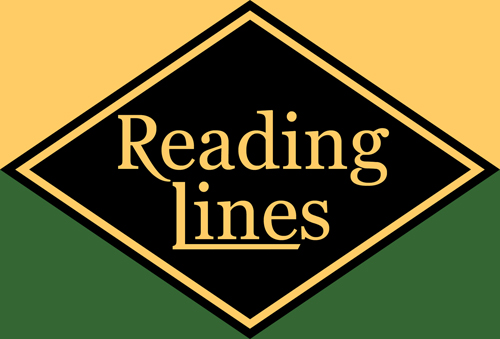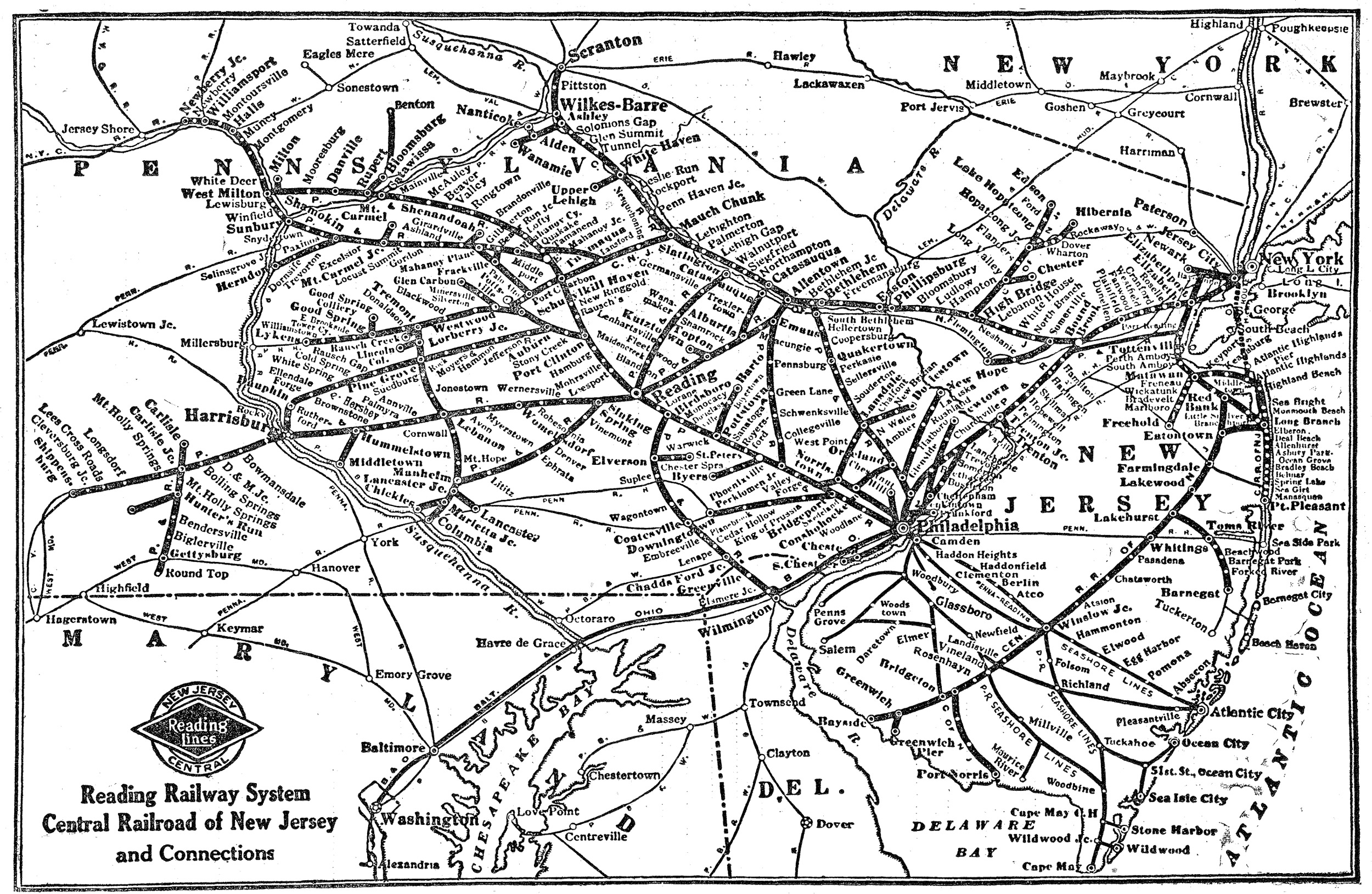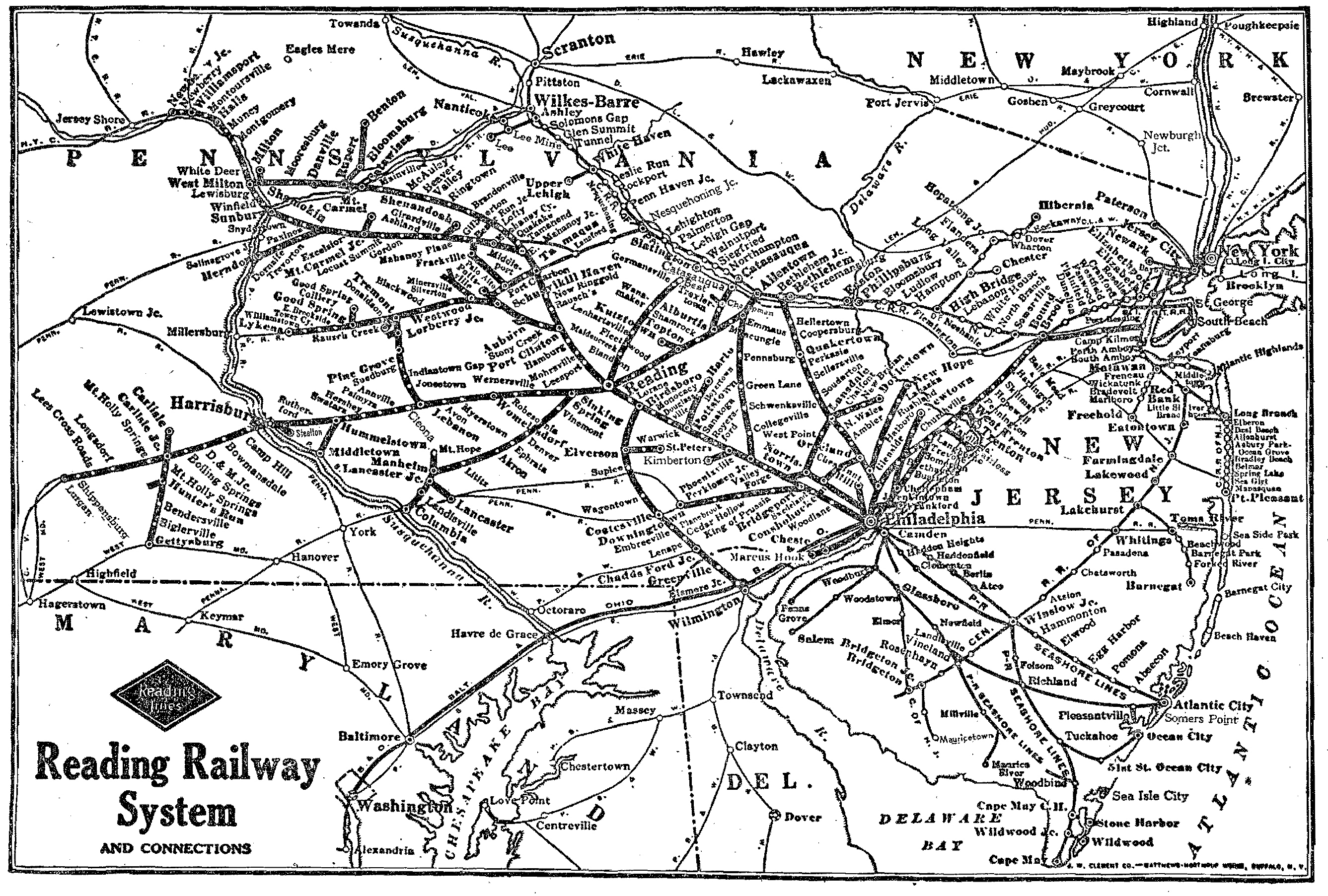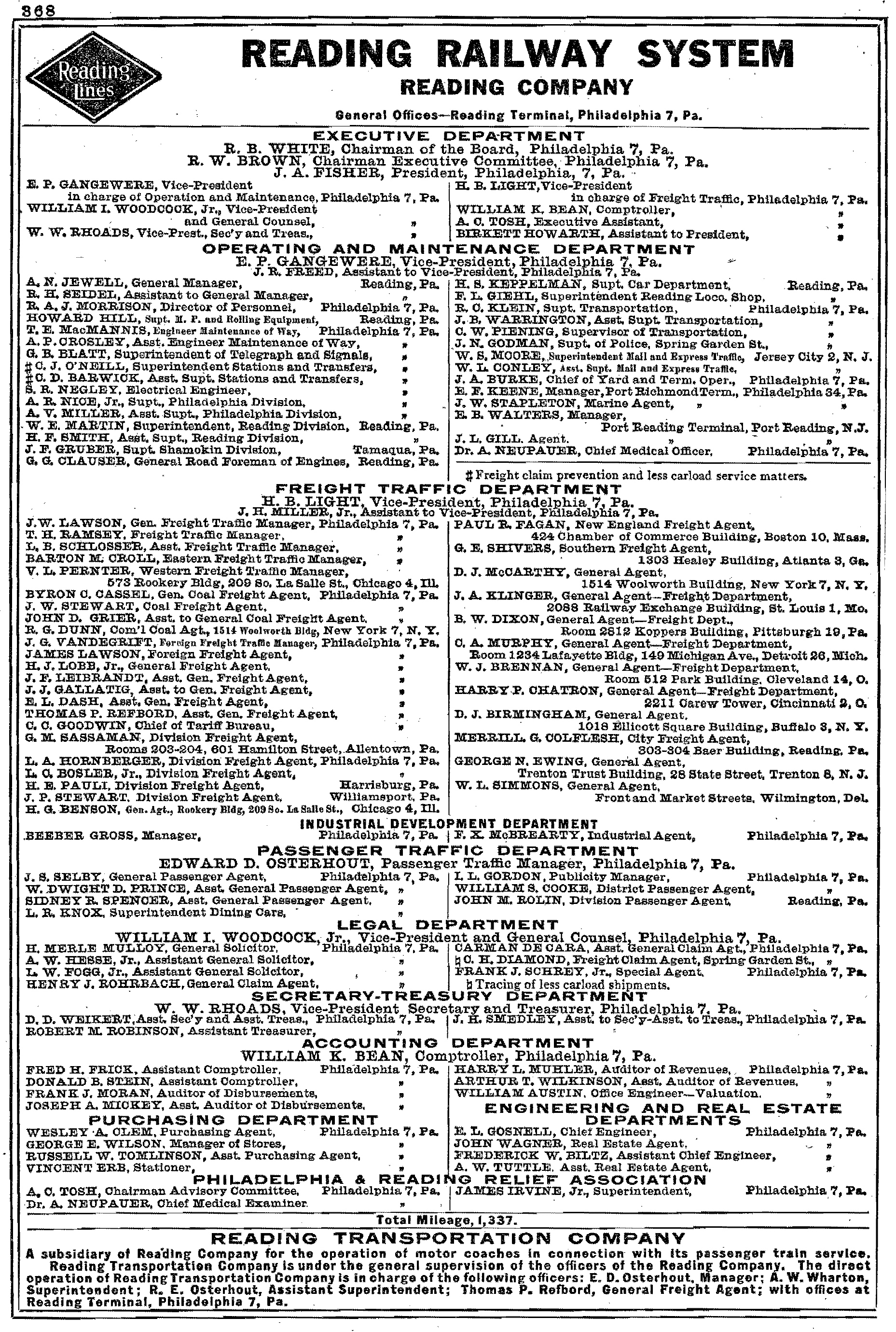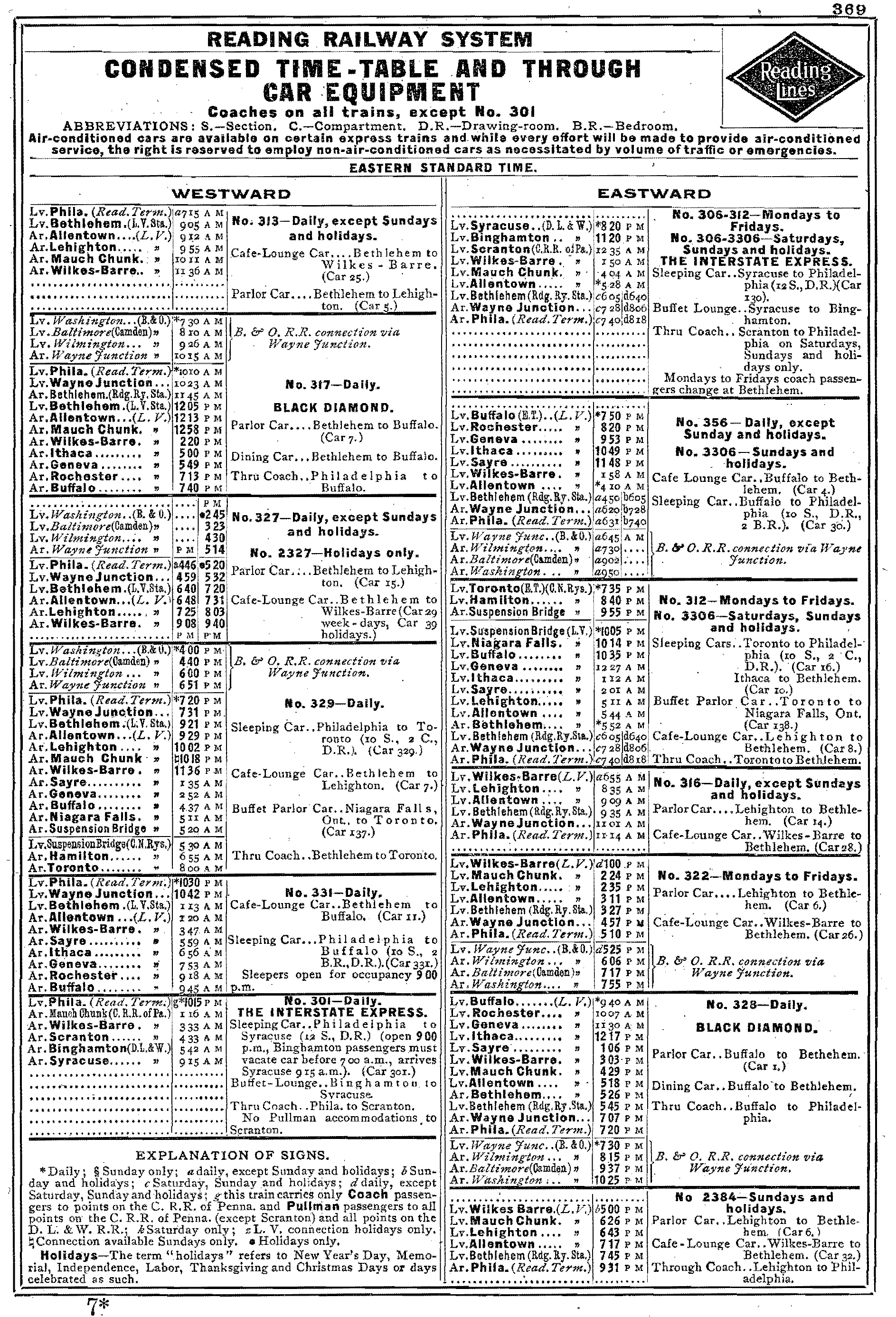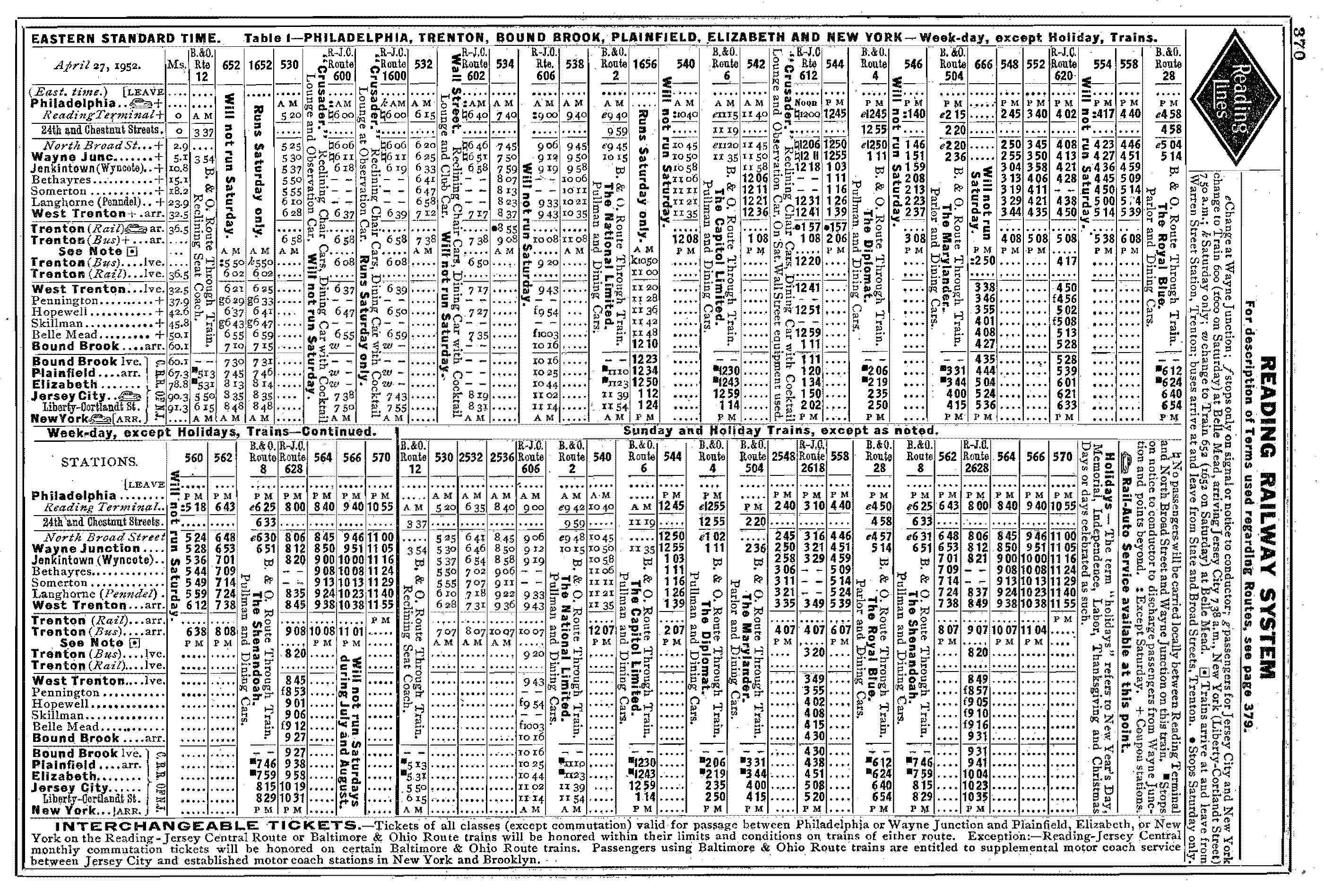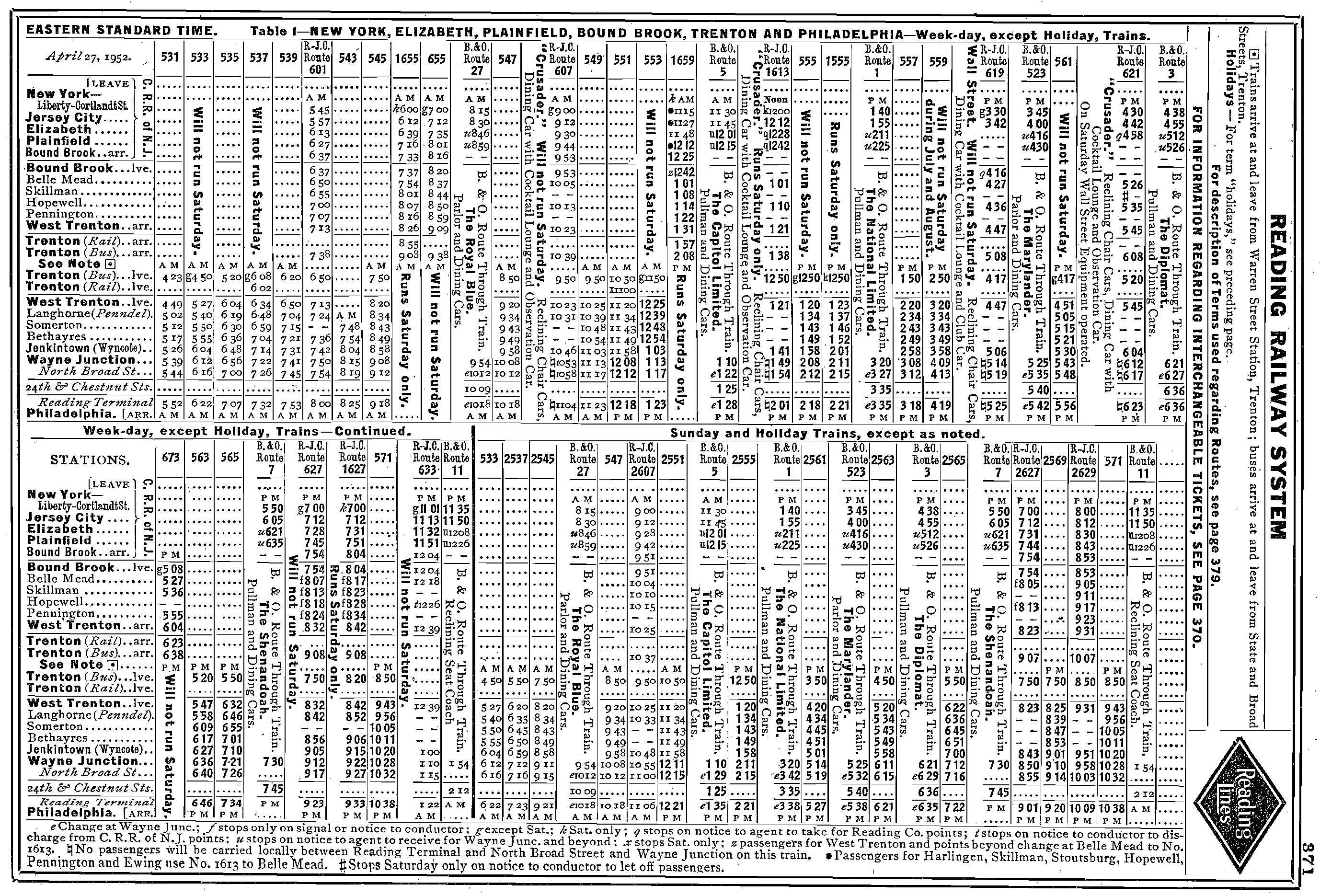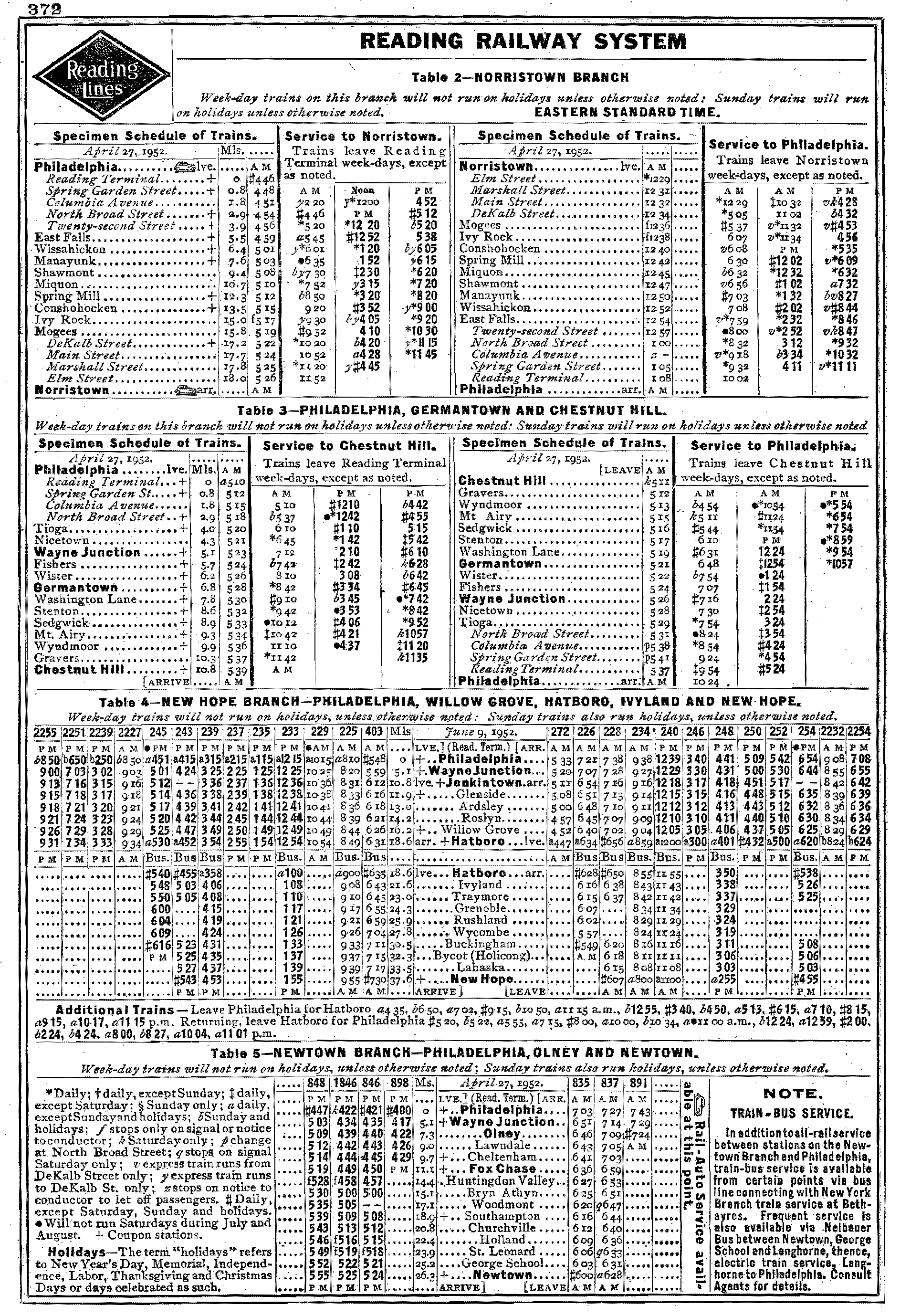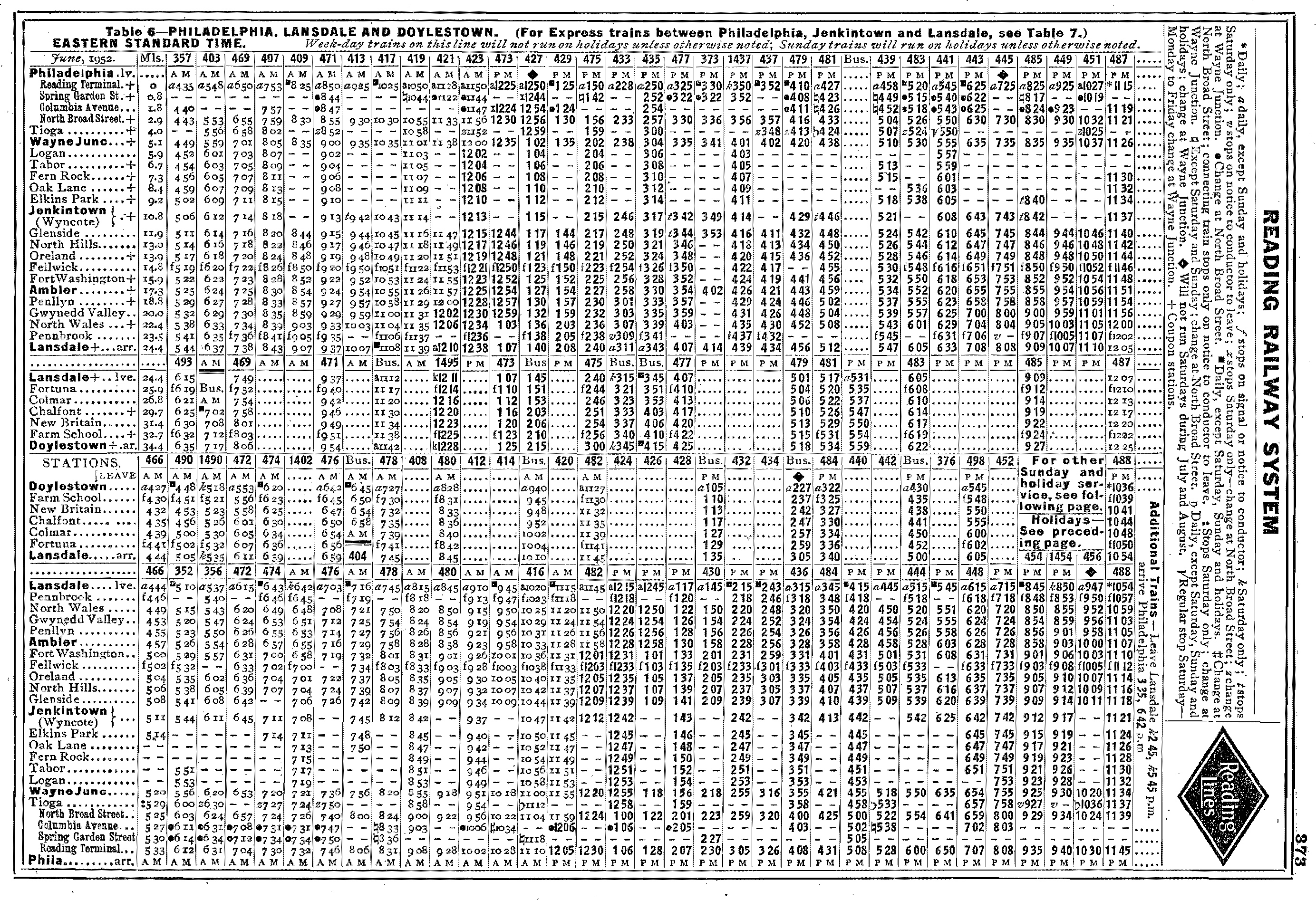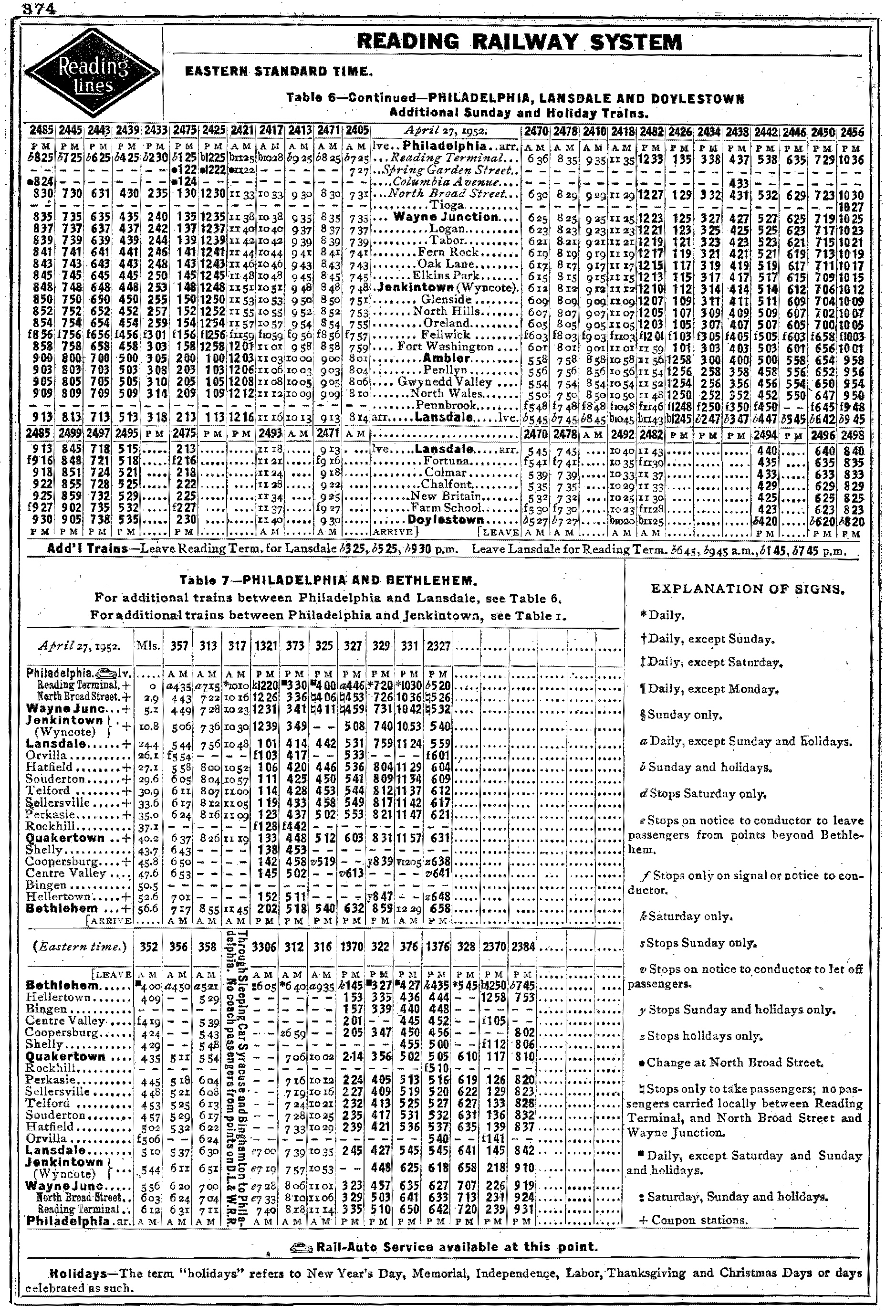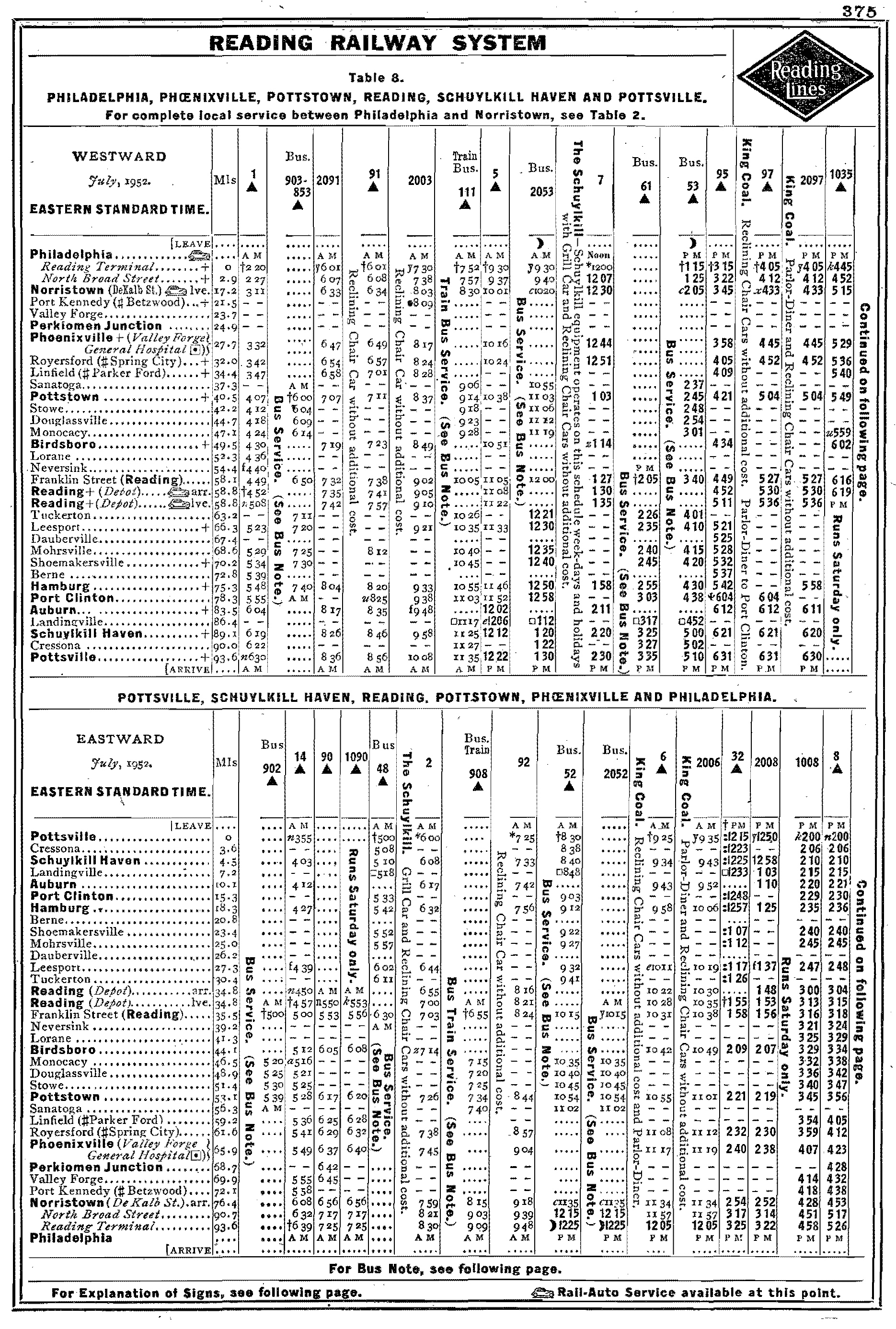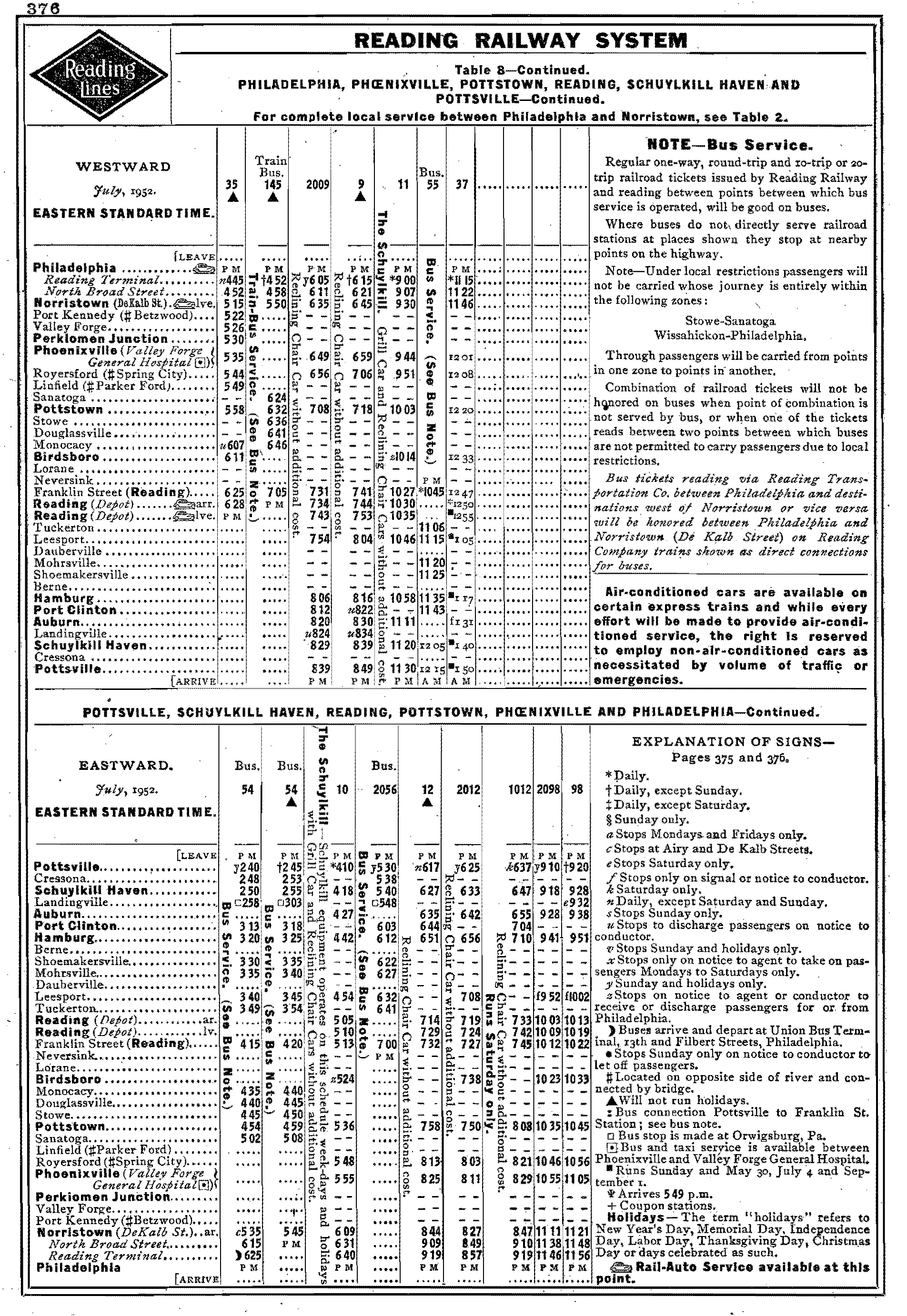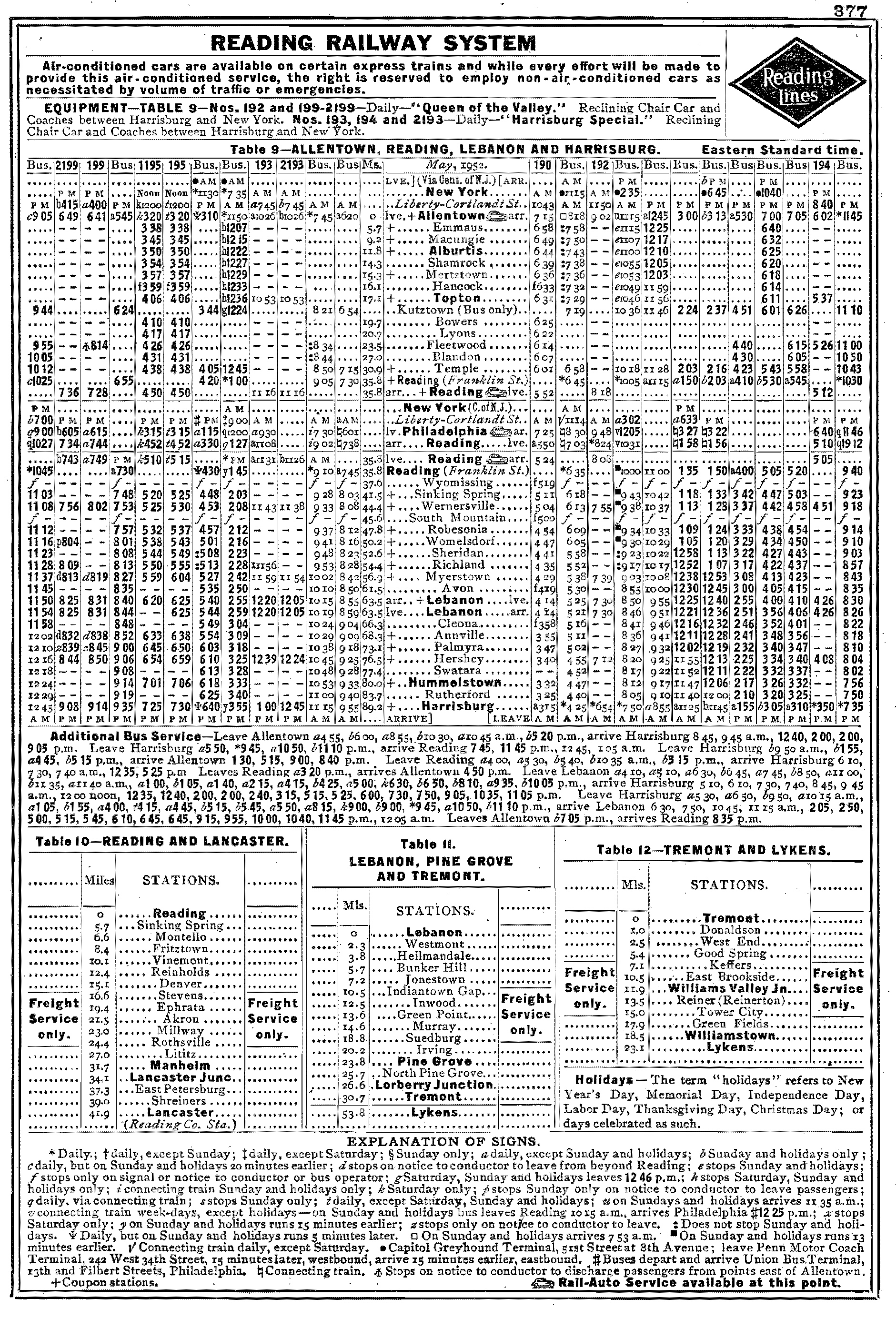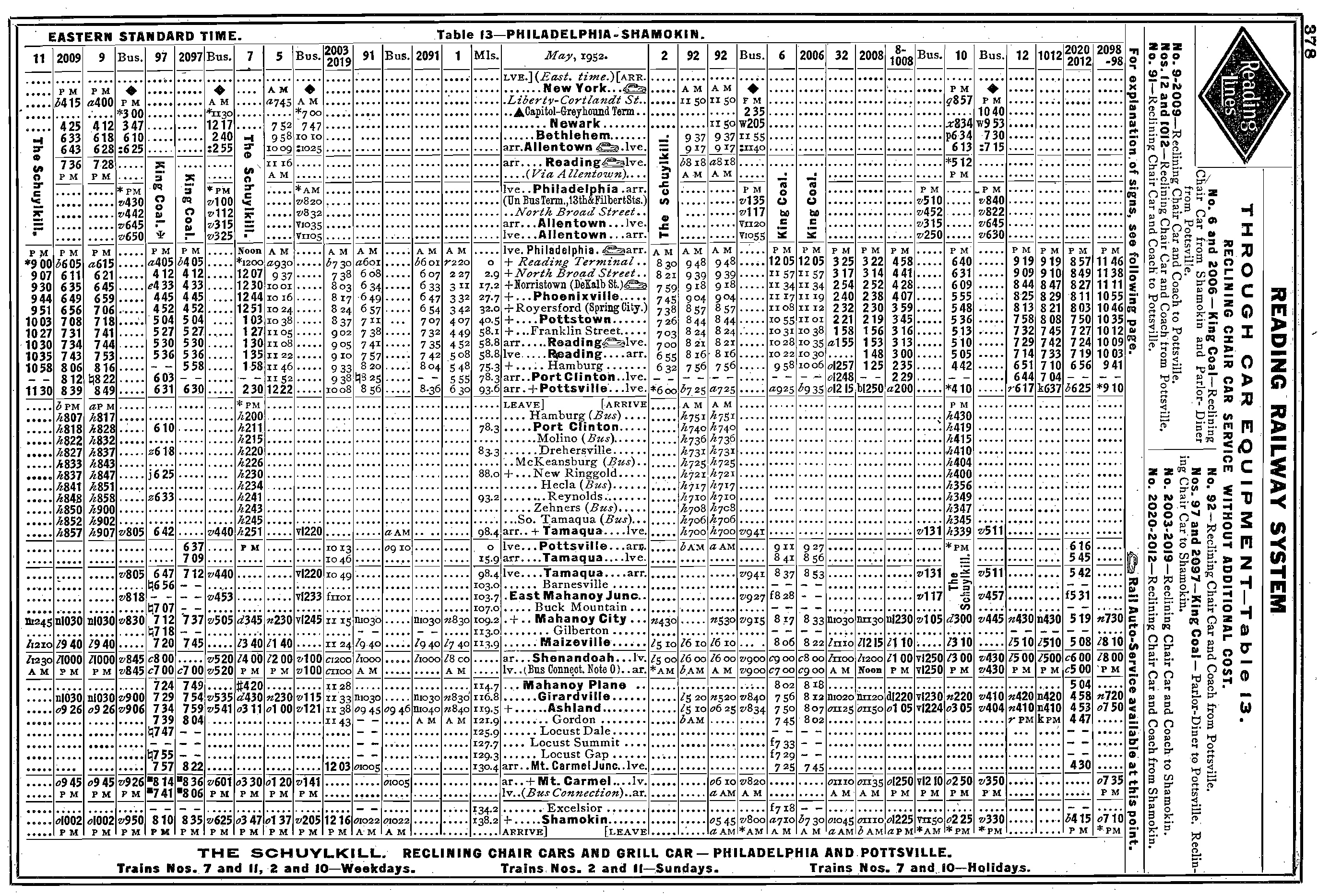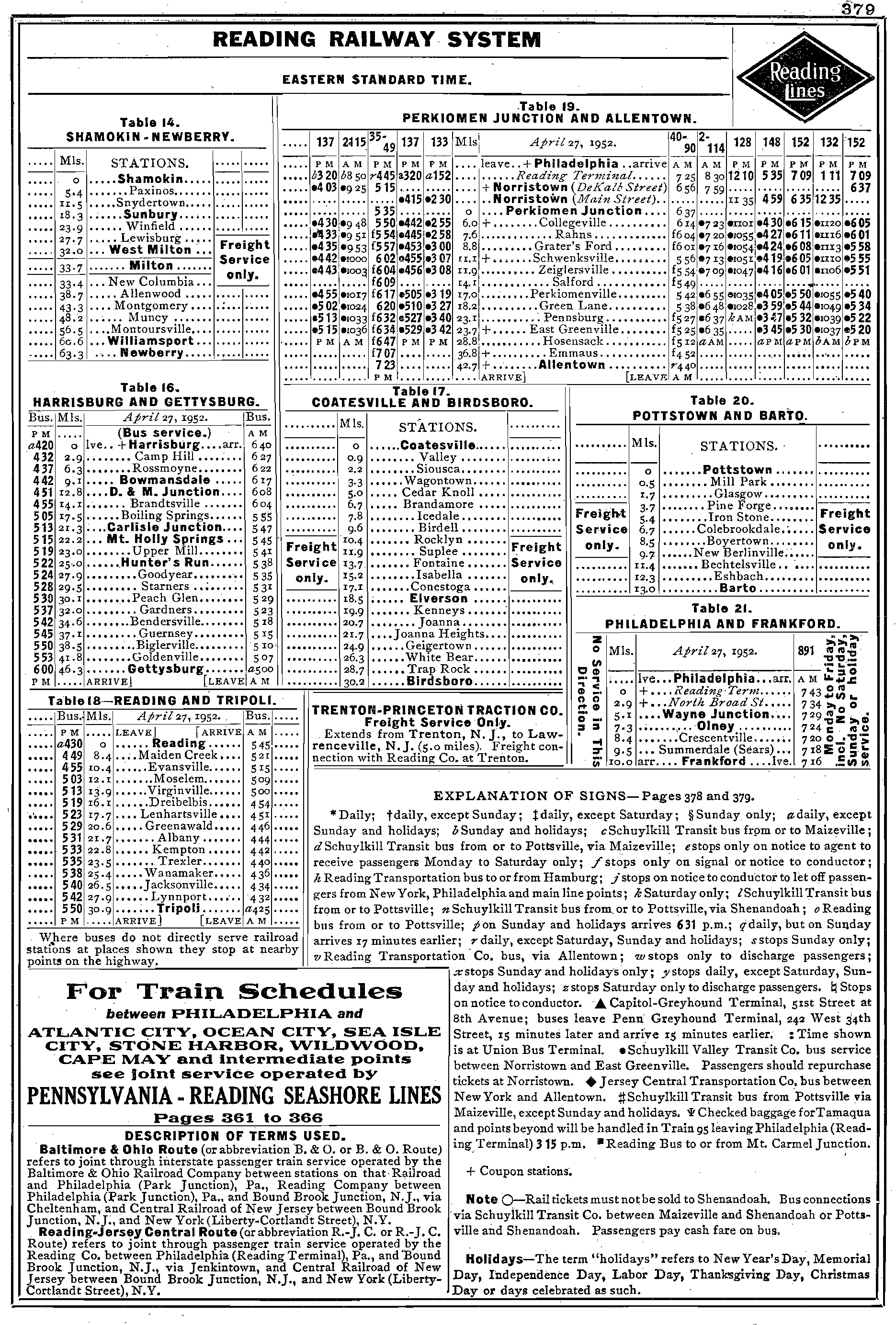Reading Railroad: Map, Logo, History, Rosters
Last revised: October 17, 2024
By: Adam Burns
The Reading Railroad (pronounced "Redding"), officially known as the Reading Company, was another of the many Northeastern anthracite carriers and arguably the most famous.
Unfortunately, despite its celebrity the carrier relied heavily on a commodity which precipitously declined after World War II.
Before the fall, it was a powerful system that, at one point, nearly cornered the lucrative coal market by holding stakes in virtually all of the region's major railroads.
Its goal in this endeavor ultimately failed and the company settled into operating a haphazard, tentacled network radiating out of Reading, Pennsylvania.
Its system was largely devoid of a main line except for a small spine west of Philadelphia. Following Penn Central's collapse the Reading fell into bankruptcy in 1971.
With a reeling situation in the Northeast, Conrail was formed to clean up the mess. The Reading was included in the new government-sponsored operation, which ultimately retained many of its principle lines.
Photos
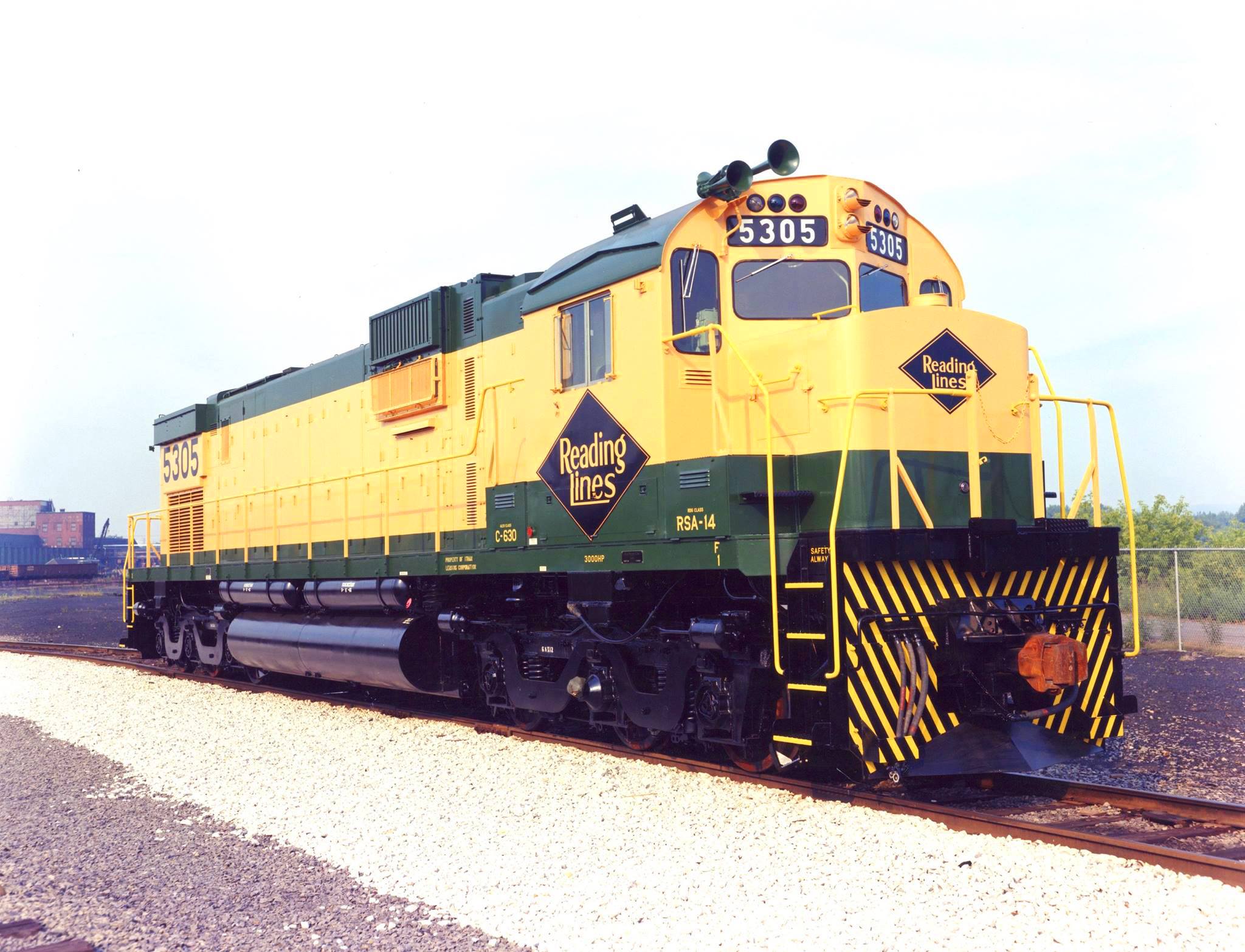 An American Locomotive builder's photo featuring freshly outshopped Reading C630 #5305 in June of 1966. Warren Calloway collection.
An American Locomotive builder's photo featuring freshly outshopped Reading C630 #5305 in June of 1966. Warren Calloway collection.History
When the clean-burning fuel, known as anthracite coal, was discovered in northeastern Pennsylvania during the mid-18th century individuals began studying ways of transporting the product for commercial use. The first to do so successfully was the Lehigh Coal Mine Company of 1792.
Into the early 1800s the idea of waterway transportation, better known as canals, drew increasing support. It was New York which proved the concept's viability by opening the famous Erie Canal on October 26, 1825, running across the state from Buffalo to Albany, then down the Hudson River into New York.
According to Jim Shaughnessy's book, "Delaware & Hudson: The Bridge Line," on April 22, 1828 the Delaware & Hudson Canal Company first entered revenue service.
It was one of Pennsylvania's earliest such operations and became a profitable venture handling anthracite from near Honesdale to Kingston. From that point the coal was transported down the Hudson into New York. The origins of the Reading Railroad began just this way.
At A Glance
1,582 (1930) 1,286 (1950) | |
Philadelphia - Jersey City Philadelphia - Bethlehem, Pennsylvania Philadelphia - Reading, Pennsylvania Philadelphia/Camden - Atlantic City, New Jersey Manville - Port Reading, New Jersey Reading - Harrisburg, Pennsylvania Reading - Allentown, Pennsylvania Reading - Newberry Junction, Pennsylvania Reading - Wilmington, Delaware Harrisburg - Hagerstown, Maryland (Western Maryland) | |
Freight Cars: 43,298 Passenger Cars: 910 | |
Its earliest predecessor was the Little Schuylkill Navigation, Railroad & Coal Company, which was granted a charter by the state of Pennsylvania on February 28, 1826.
It planned to move coal from mines near the Panther Creek Valley at Tamaqua to Port Clinton (about 20 miles) where the product would then be transferred to the Schuylkill Navigation Company's canal linking Reading and Philadelphia.
Logo
The route's construction began in earnest during 1830 and it was opened in 1831 utilizing horses pulling carts over wooden rails with iron straps.
The rudimentary operation was slow and ground to halt during the late fall through early spring when frigid temperatures kept the canals frozen and unnavigable.
Still, as the D&H operation proved, demand for anthracite was so great there remained a bright future in the business. To overcome the obstacles of winter the state legislature authorized construction of the Philadelphia & Reading Railroad on April 4, 1833.
This newfangled technology could run in every type of weather as the Baltimore & Ohio, Mohawk & Hudson, South Carolina Canal & Rail Road, and others were all proving.
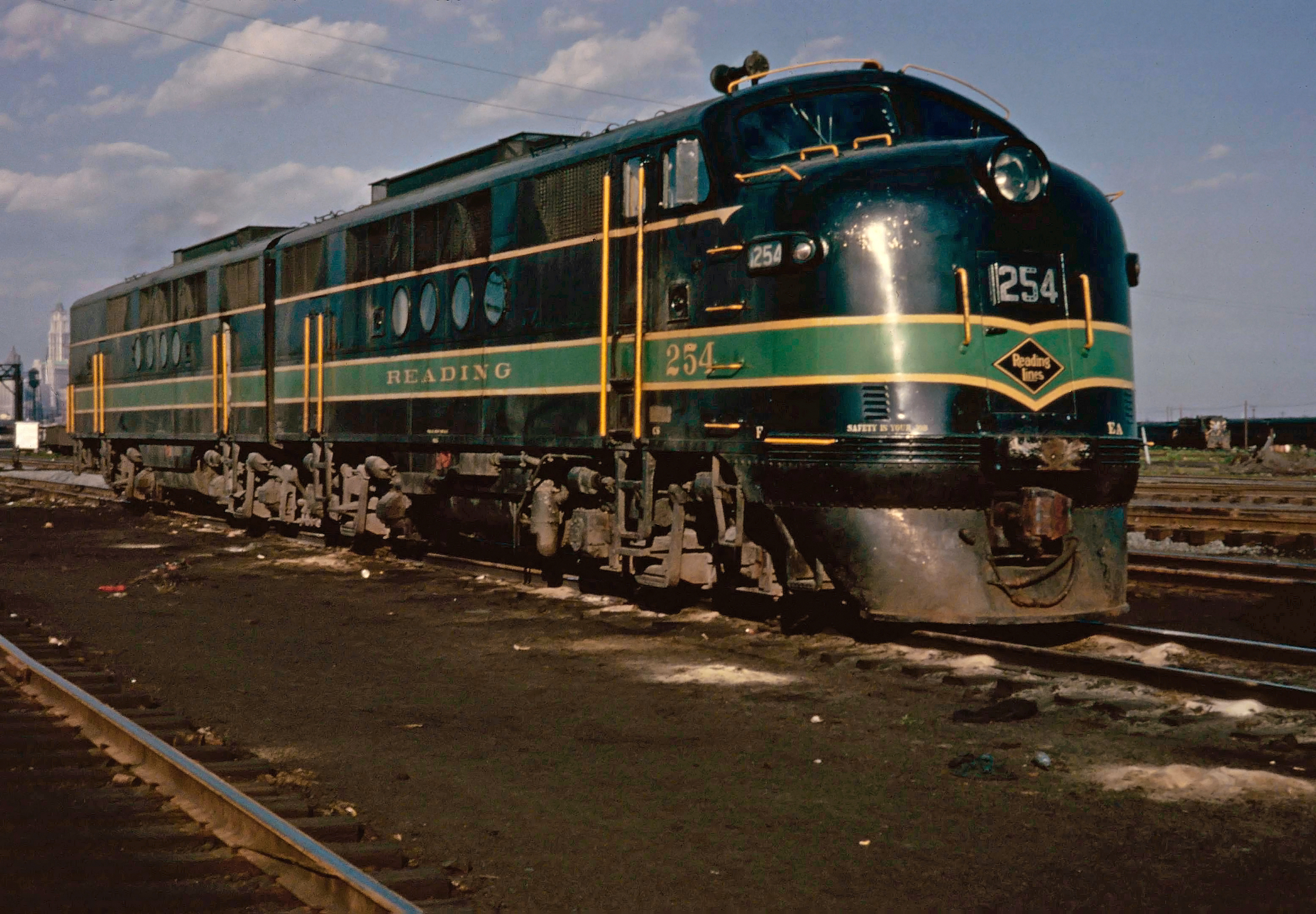 An A-B set of handsome Reading FT's were photographed here at Jersey Central's Communipaw Terminal in Jersey City, New Jersey, circa 1955. American-Rails.com collection.
An A-B set of handsome Reading FT's were photographed here at Jersey Central's Communipaw Terminal in Jersey City, New Jersey, circa 1955. American-Rails.com collection.The P&R was the earliest ancestor of the Reading's railroad operations. It was envisioned to replace the canal, connecting Pottsville with Philadelphia via Reading running parallel with the Schuylkill River.
During this era railroads struggled to gain a footing in the face of stiff canal opposition; backed with money and political connections canal owners were effective at delaying construction efforts of the Lehigh Valley, Erie, and Mohawk & Hudson (an early New York Central predecessor).
This was no different for the P&R, which fought local canal interests for years until opening its first segment between Reading and Pottstown in 1838.
As time passed and railroads proved their superiority the resistance evaporated. One year later, on December 5, 1839, the P&R completed its line into Philadelphia while the final extension to Pottsville opened in 1842.
Interestingly, this 93-mile route was the only true main line the Reading ever operated. The rest of its network consisted primarily of branch and secondary lines.
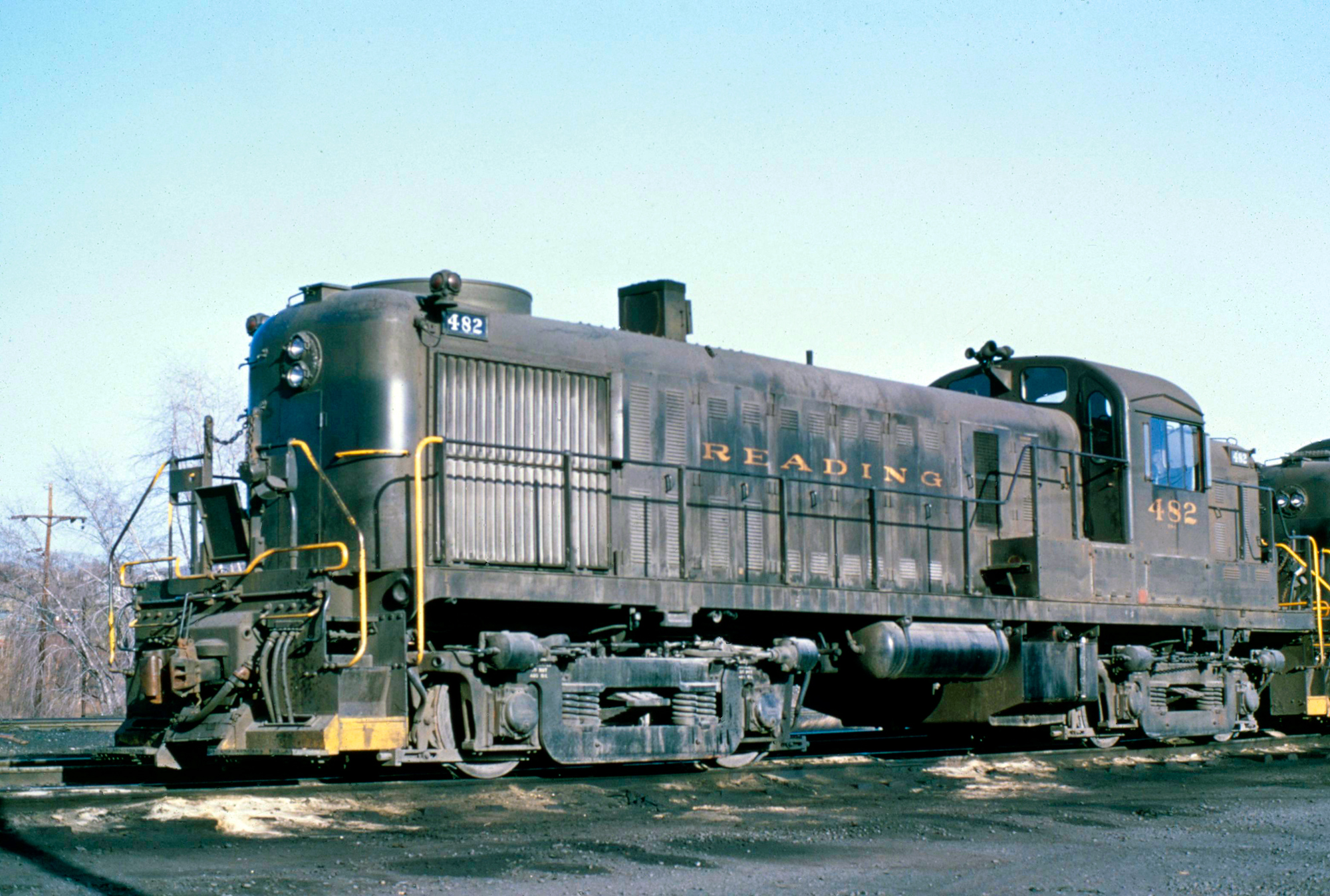 The RS3 was quite popular on the Reading. Seen here is #482 at Cressona, Pennsylvania on April 11, 1971. Charles Houser, Sr. photo. Author's collection.
The RS3 was quite popular on the Reading. Seen here is #482 at Cressona, Pennsylvania on April 11, 1971. Charles Houser, Sr. photo. Author's collection.Dale Woodland notes in this book, "Reading Diesels: Volume 2, The Second Generation," the opening of a coal terminal at Port Richmond along the Delaware River in Philadelphia on May 17, 1842 provided the railroad with an eastern outlet for its anthracite.
The P&R proved, once more, that rail transportation was superior to the canal. According to Mike Schafer's book, "Classic American Railroads: Volume III," in 1844 it handled 42,843 tons of coal, surpassing the Schuylkill Canal.
As the P&R's success blossomed it expanded by acquiring other railroads, most of which branched in every direction away from Reading.
This city ultimately became the P&R's primary hub where its major shop complex was located. Its growth into the modern-day Reading Company unofficially began on January 1, 1850 when it acquired a portion of the Philadelphia & Columbia Railroad between Philadelphia and Columbia.
It then purchased the Lebanon Valley Railroad on March 20, 1858 which linked Reading with the state capital at Harrisburg (the LVRR opened on January 18, 1858).
The P&R's other notable acquisitions included the following:
- In 1869 it added the East Pennsylvania Railroad to Allentown; in 1870 it picked up the Philadelphia, Germantown & Norristown Railroad via lease running to Norristown (a Philadelphia suburb)
- 1872 saw the takeover of the Catawissa, Williamsport & Erie extending to Williamsport and Newberry Junction
- On May 14, 1879 it purchased the North Pennsylvania Railroad which extended service to the important steel-production center at Bethlehem and that same year added the Delaware & Bound Brook Railroad (D&BB).
The D&BB had been incorporated on May 12, 1874, opening a line five years later from Yardley (interchanging there with the North Penn Railroad) to Bound Brook Junction (near Manville, New Jersey) where it connected with the Central Railroad of New Jersey.
The D&BB later completed an extension to Woodbridge, New Jersey where Port Reading was opened in 1889 along the New York Harbor. At this location a vital deep water port was built for the transportation of anthracite onto Transatlantic ships.
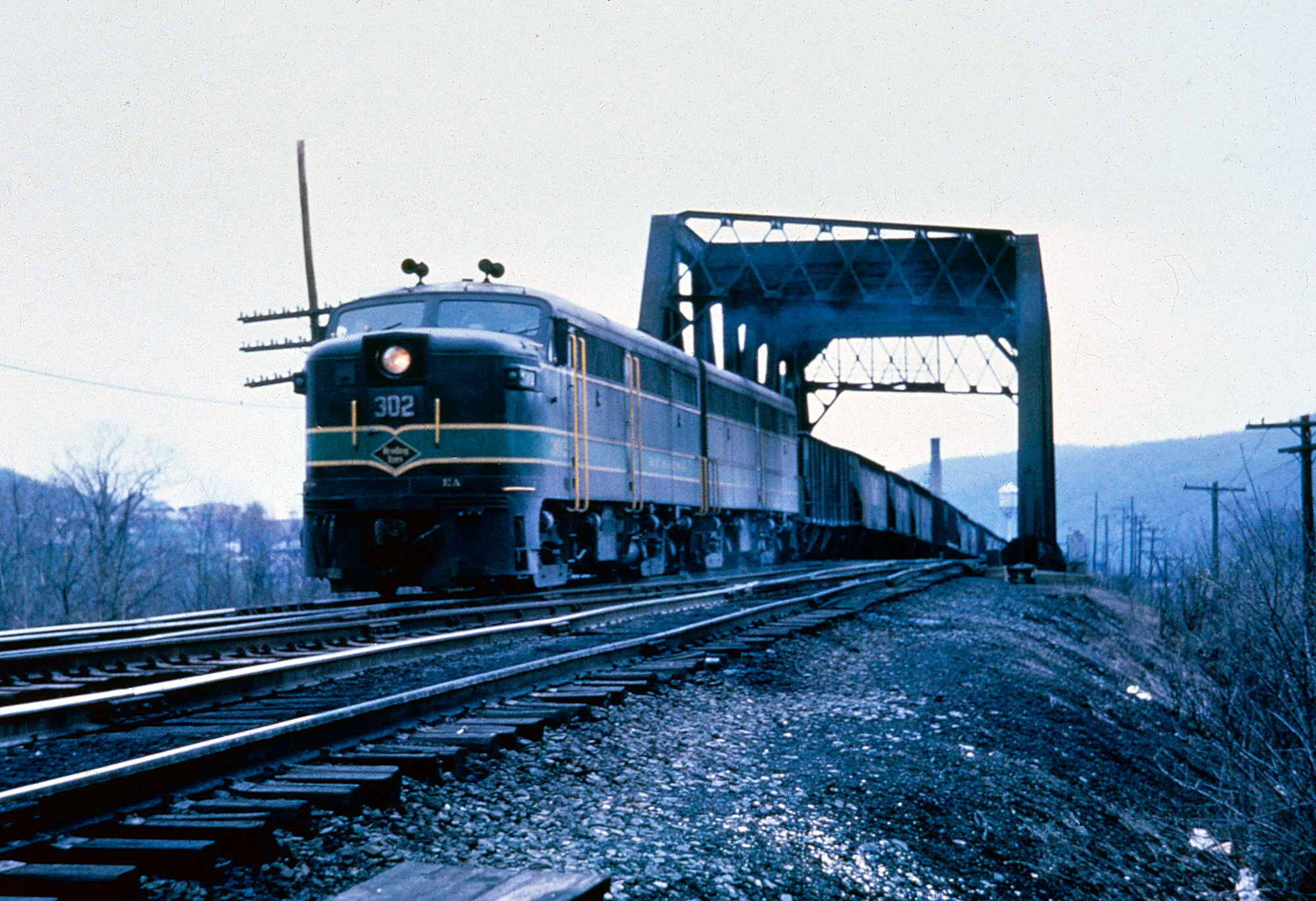 Reading FA-1 #302 and a cabless mate have what appears to be a string of empties heading westbound through Allentown, Pennsylvania during the 1950's. Author's collection.
Reading FA-1 #302 and a cabless mate have what appears to be a string of empties heading westbound through Allentown, Pennsylvania during the 1950's. Author's collection.These systems were the most important components of the P&R's network although, as Mr. Woodland points out, nearly 100 predecessors ultimately comprised the modern Reading Company system. As the 1800s came to a close the railroad continued to prosper with demand for anthracite soaring.
The P&R was not the only carrier to flourish by handling hard, or stone coal. Other successful anthracite systems included the aforementioned Delaware & Hudson, Lehigh Valley, and Delaware, Lackawanna & Western as well as the Jersey Central, Lehigh & New England, Lehigh & Hudson River, and New York, Ontario & Western.
The road truly came of age when Franklin Gowen was elected president in early 1870. He looked to corner the coal market by establishing the Philadelphia & Reading Coal & Iron Company in 1871.
This subsidiary worked to acquire mines for the railroad and was so fruitful that Mr. Schafer notes it controlled nearly 30% of the anthracite market before overextending itself and falling into bankruptcy in 1880.
After a series of presidents, Archibald McLeod took the reigns in 1890 leading the Philadelphia & Reading through what could arguably be described as its greatest period. The new president aimed to transform his company into the dominant anthracite carrier.
Backed by the P&R's overflowing wealth the beautiful Reading Terminal in downtown Philadelphia opened in January of 1893 (another McLeod endeavor), symbolizing the company's power.
System Map (1940)
Beginning in late 1891 it leased the Lehigh Valley and soon afterward held stakes in the Jersey Central, Lackawanna, and even Boston & Maine.
At this time the P&R controlled over 70% of the anthracite business and appeared would enter the 20th century as the region's largest railroad. Alas, the financial Panic of 1893 brought down the McLeod empire although the P&R did maintain control of the CNJ.
The company was forced into receivership and all of the rail and non-rail properties under its control except the CNJ were reorganized as the Reading Company.
System Map (1969)
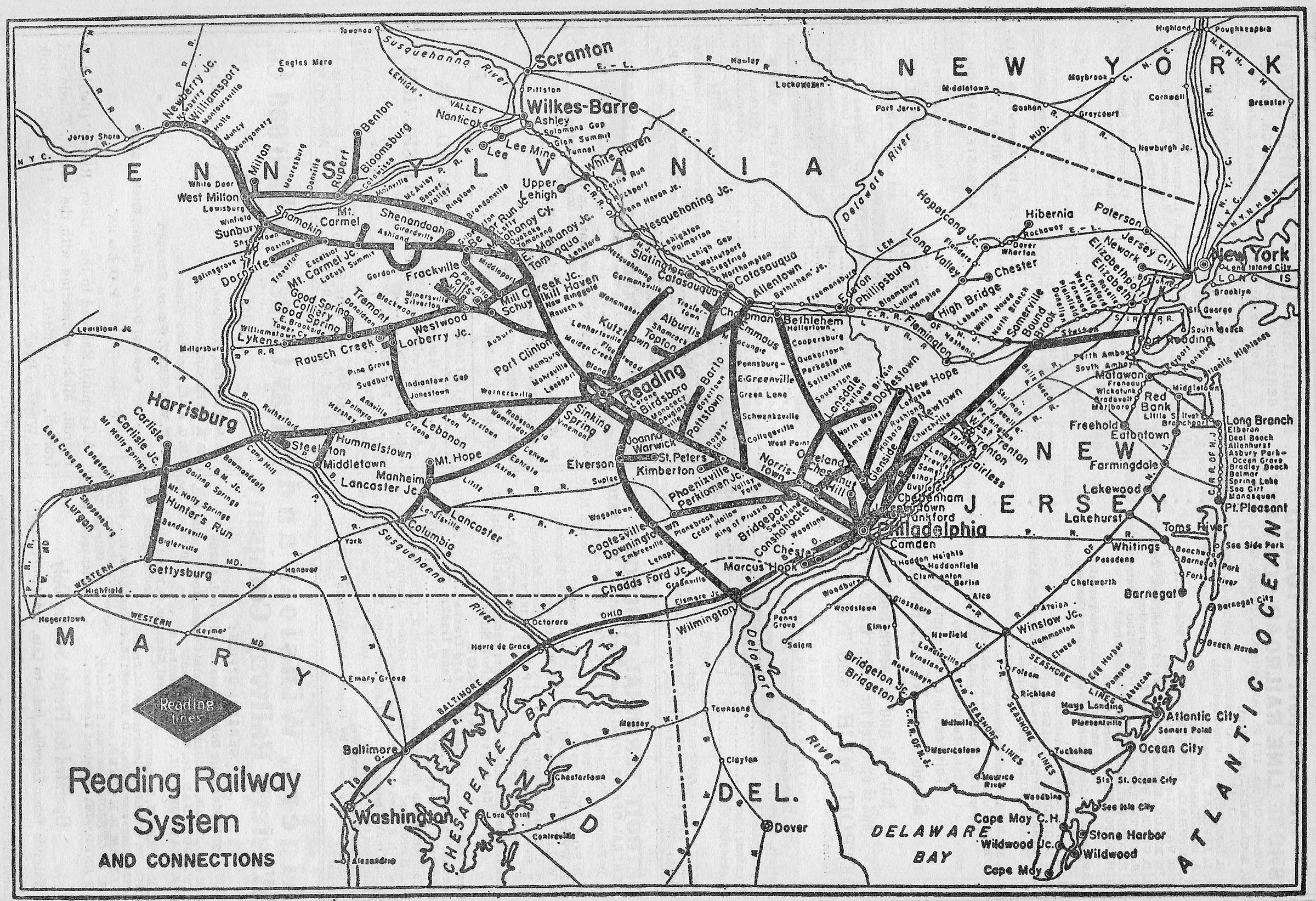 An official, 1969 system map of the Reading Railroad by Rand McNally & Company. Author's collection.
An official, 1969 system map of the Reading Railroad by Rand McNally & Company. Author's collection.Less than a decade later Reading was acquired, through stock ownership, by the much larger Baltimore & Ohio. The 1893 collapse relegated it to regional status, operating right around 1,300 miles within eastern Pennsylvania and its New Jersey commuter lines.
Because of the company's condensed, spaghetti-like network it could not enjoy the lucrative, long-haul movements of merchandise freight that trunk lines like the B&O, NYC, and PRR enjoyed. Its absolute furthest run over home rails was 202 miles from Newberry Junction (near Williamsport) to Philadelphia.
It did, however, go on to join the "Alphabet Route." This consortium included a group of railroads that offered through service for shippers in the ultra-competitive New York/Boston - Chicago corridor as an alternative to the B&O, NYC, and PRR.
In a further corporate reorganization it shed all of its non-rail interests in 1923 due to antitrust issues. During the next few decades the Reading maintained a highly profitable and well-managed operation thanks to its rich sources of coal.
Commuter Services
When the vacationing market to New Jersey's beaches sprang up after the Civil War the P&R looked to expand into the region. In 1884 it purchased the narrow-gauge Camden, Gloucester & Mt. Ephraim Railway, which connected its namesake cities in New Jersey.
The little operation was soon standard-gauged and through a series of other acquisitions the P&R consolidated all of its southern New Jersey properties into the Atlantic City Railroad in 1889.
As the popularity of beach goers exploded through the late 19th century the ACRR was double-tracked along an arrow-straight main line linking Camden with Atlantic City.
In 1933 the ACRR joined Pennsylvania's West Jersey & Seashore Railroad to form the Pennsylvania-Reading Seashore Lines, a successful commuter operation linking Camden with the Jersey Shore.
The PRSL faded over time but survived until the formation of Conrail in 1976. Today, some of its lines remain in use by various agencies handling both freight and passenger assignments.
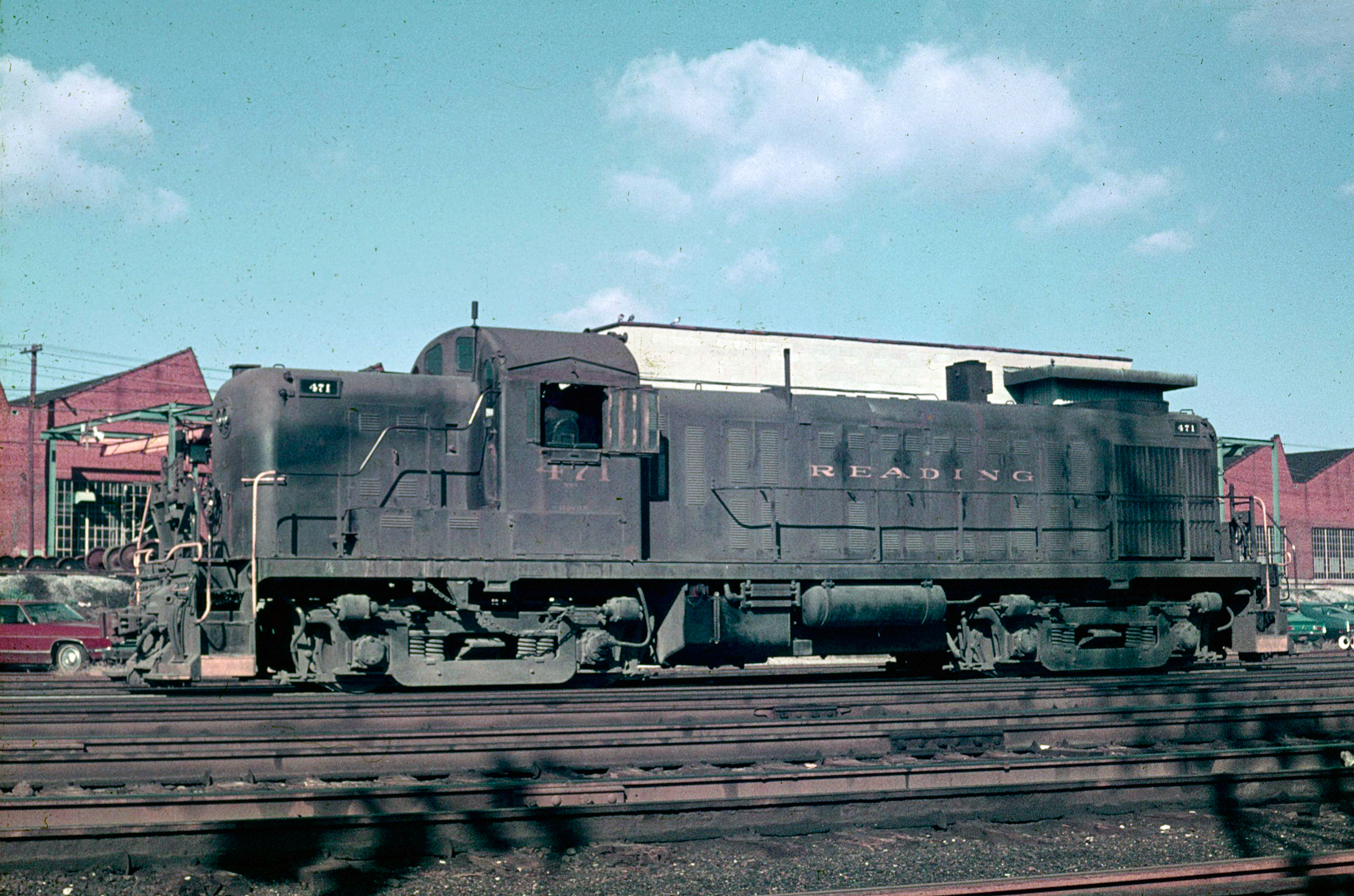 One of the Reading's numerous RS3's, #471, is seen here at the company's shops in Reading, Pennsylvania on October 8, 1972. Author's collection.
One of the Reading's numerous RS3's, #471, is seen here at the company's shops in Reading, Pennsylvania on October 8, 1972. Author's collection.Outside of commuter operations the Reading also operated a fleet of successful regional trains. Its best-remembered was the steamlined Crusader.
The train was tailored towards business clientele connecting New York/Jersey City (in conjunction with the CNJ via Jersey City Terminal) with Philadelphia.
In its initial streamlining the train was powered by a pair of overhauled 4-6-2's (these Pacifics, classed as G-1sa were rebuilt at the Reading Shops) and matched to a lightweight consist of five cars (built by the Budd Company), bedecked in stainless steel.
It was a very classy and successful operation, remaining in service through the 1960s.
There were also other notable trains such as the King Coal, Queen of the Valley, Schuylkill, and Wall Street. Considering its dependence on coal the road surprisingly operated extensive commuter services within the Philadelphia suburbs.
By the 1930s it had electrified these lines, extending from Reading Terminal to Norristown, Chestnut Hill, Doylestown, Hatboro, and West Trenton. Amazingly, even as late as the 1960s the Reading was continuing to expand these operations!
As the years passed, however, these operations lost increasingly more money, a problem facing all other Northeastern carriers. Unfortunately, it was inescapable requirement that most railroads were unable to shed until the early 1980s.
Finally, there was the Iron Horse Rambles. These popular excursions became legendary and became a fondly remembered part of Reading's history.
The event began in 1959 and eventually showcased four of its 4-8-4s leading the trips over the next five years including #2100, #2101, #2102, and #2124. Their popularity kept the trains running far longer than the railroad had originally envisioned!
The Rambles were not only a successful public relations campaign during an era when railroads were far more friendly, welcoming, and open to the general public but also demonstrated the importance steam power once played.
The decline of this traffic began in the 1920s and hastened after World War II. Mr. Woodland notes that in 1946 the Reading still handled 16 million tons of anthracite with roughly 30 million tons in other freight.
Unfortunately, the loss of its key traffic source quickened through the 1960s and by 1975 it was handling less than 2 million tons.
As the 1960s unfolded the anthracite market had almost entirely dried up resulting in the Reading depending heavily on bridge traffic. The entire Northeastern industry was seriously hurt by the formation of the Penn Central Transportation in February of 1968.
Almost immediately the PC began to crumble and along with it most other carriers. On June 21, 1970 the PC declared bankruptcy followed by the Reading on November 23, 1971. Things went from bad to worse as the PC threatened total shutdown if some assistance was not provided.
The Reading relied on some very large and powerful wheel arrangements during its heyday such as 2-8-8-2's, 2-8-8-0's, 2-10-0's, 2-10-2's, and others alongside the 4-8-4's (rebuilt from former 2-8-0 Consolidations).
Into the diesel era it experimented with examples from all of the major manufacturers, including Fairbanks-Morse's unique H24-66 "Train Master" of the 1950s.
Passenger Trains
Crusader: (New York/Jersey City - Philadelphia)
Harrisburg Special: (Jersey City - Harrisburg)
King Coal: (Philadelphia - Shamokin, Pennsylvania)
North Penn: (Philadelphia - Bethlehem)
Queen of the Valley: (Jersey City - Harrisburg)
Schuylkill: (Philadelphia - Pottsville)
Wall Street: (Philadelphia - Jersey City)
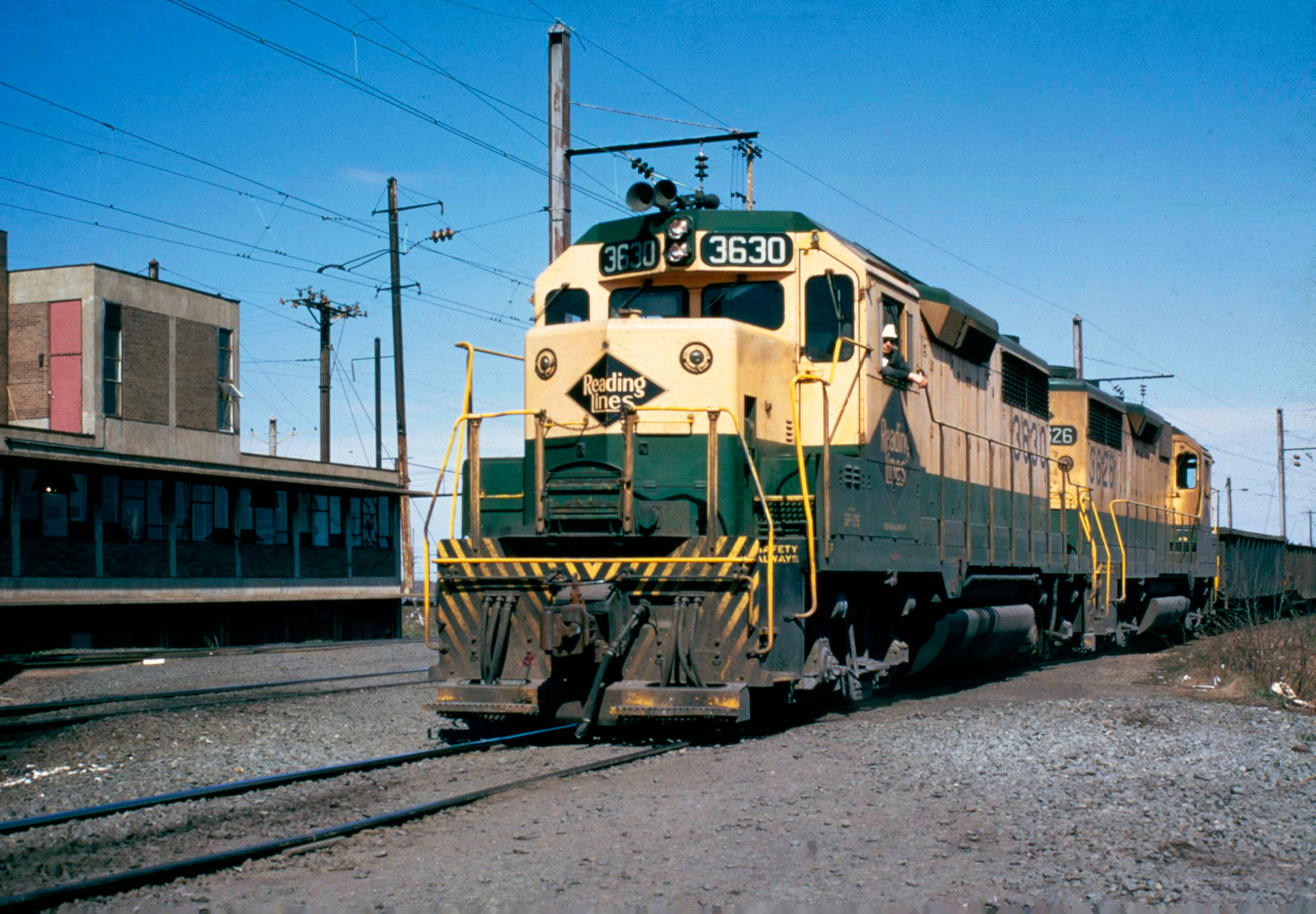 A pair of Reading GP35's were photographed here at Morrisville, Pennsylvania during the mid-1960s. American-Rails.com collection.
A pair of Reading GP35's were photographed here at Morrisville, Pennsylvania during the mid-1960s. American-Rails.com collection.However, it generally relied on examples from Electro-Motive and American Locomotive. There were first-generation GP7's, F7's, and RS3's while second-generation variants included models like the C630, GP30, and GP40-2.
The early examples wore a striking livery of black with green and yellow pinstriping while later locomotives were clad in a bright green and yellow scheme featuring a large black diamond below the cab with the company name.
Diesel Roster
American Locomotive Company
| Model Type | Road Number | Date Built | Quantity |
|---|---|---|---|
| HH-900 | 40-41 | 1937-1938 | 2 |
| S2 | 42-47 | 1946-1947 | 6 |
| Boxcab | 50-51 (First) | 1926, 1928 | 2 |
| S1 | 50-54 (Second) | 1940-1941 | 5 |
| FA-1 | 300A-305A | 1948 | 6 |
| FB-1 | 300B-305B | 1948 | 6 |
| RS3 | 444-450, 460-475, 481-524 | 1951-1953 | 67 |
| C424 | 5201-5210 | 1963 | 10 |
| C430 | 5211-5212 | 1966 | 2 |
| C630 | 5300-5311 | 1966-1967 | 12 |
Baldwin Locomotive Works
| Model Type | Road Number | Date Built | Quantity |
|---|---|---|---|
| DS-4-4-1000 | 26-39, 700-729 | 1946-1949 | 44 |
| VO-660 | 36, 61-70 | 1939-1942 | 11 |
| VO-1000 | 55-59, 71-89 | 1940-1944 | 24 |
| AS16 | 530-554, 560-563, 576-589 | 1951-1953 | 43 |
Electro-Motive Division
| Model Type | Road Number | Date Built | Quantity |
|---|---|---|---|
| SW | 10-15 | 1937 | 6 |
| SW1 | 16-24 | 1939-1941 | 9 |
| NW2 | 90-92, 100-104 | 1940-1947 | 8 |
| FTA | 250A-259A | 1945 | 10 |
| FTB | 250B-259B | 1945 | 10 |
| F3A | 260A-265A | 1948 | 6 |
| F3B | 260B-265B | 1948 | 6 |
| F7A | 266-283 | 1950 | 18 |
| F7B | 266B-271B | 1950 | 6 |
| GP7 | 600-636, 660-666 | 1952-1953 | 44 |
| FP7 | 900-907 | 1950-1952 | 8 |
| SW900 | 1501-1515 | 1961-1963 | 15 |
| SW1001 | 2601-2625 | 1973 | 25 |
| SW1500 | 2750-2770 | 1966-1969 | 21 |
| MP15DC | 2771-2780 | 1974 | 10 |
| GP39-2 | 3401-3420 | 1974 | 20 |
| GP35 | 3626-3656, 6501-6506 | 1963-1965 | 37 |
| GP40-2 | 3671-3675 | 1973 | 5 |
| GP30 | 5501-5520 | 1962 | 20 |
| SD45 | 7600-7604 | 1967 | 5 |
Fairbanks-Morse
| Model Type | Road Number | Date Built | Quantity |
|---|---|---|---|
| H24-66 (Train Master) | 800-808, 860-867 | 1953-1956 | 17 |
General Electric
| Model Type | Road Number | Date Built | Quantity |
|---|---|---|---|
| U30C | 6300-6304 | 1967 | 5 |
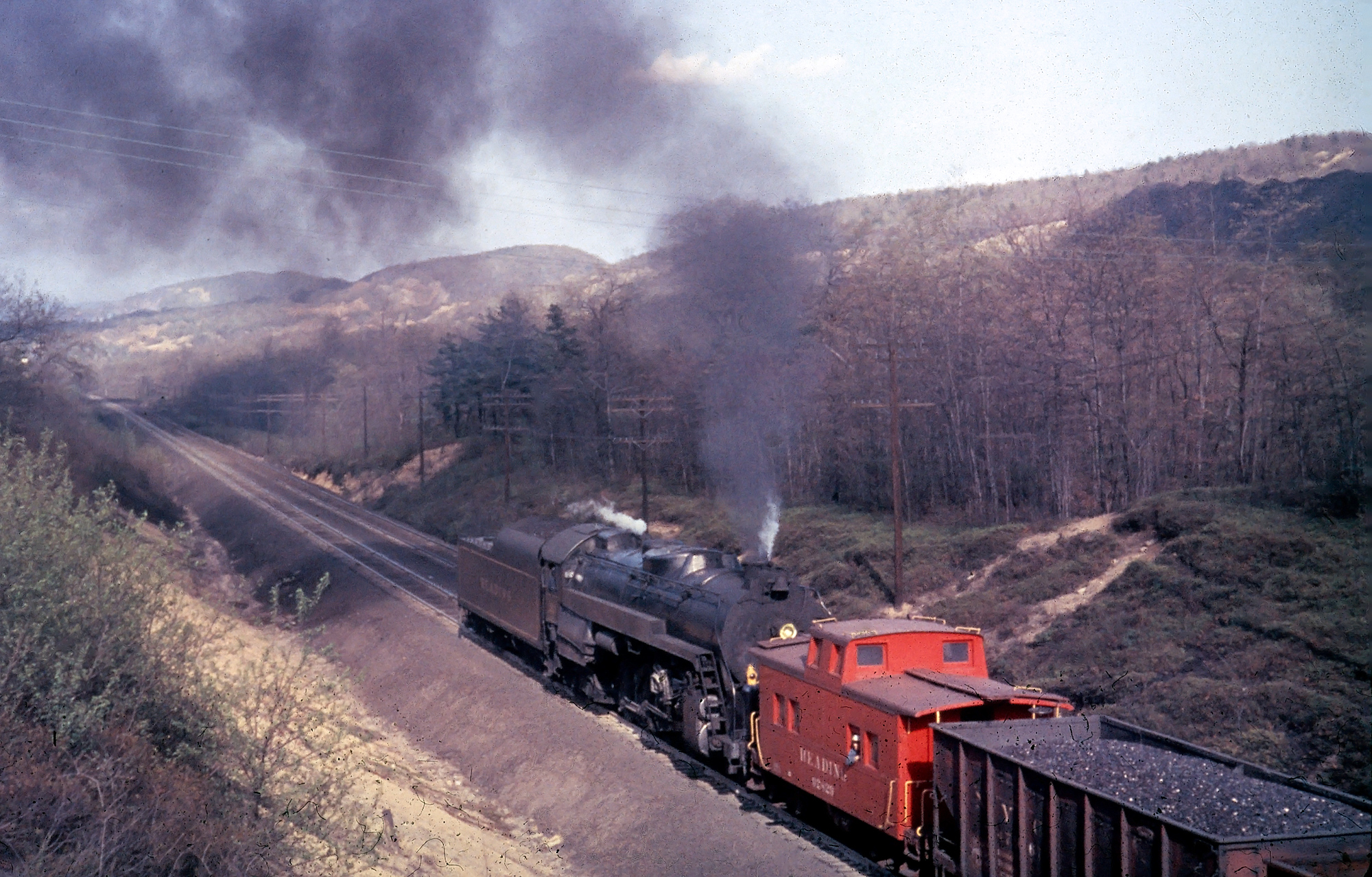 A Reading 4-8-4 (T-1) assists a westbound coal drag passing the massive slag pile at Locust Summit, Pennsylvania, circa 1950. American-Rails.com collection.
A Reading 4-8-4 (T-1) assists a westbound coal drag passing the massive slag pile at Locust Summit, Pennsylvania, circa 1950. American-Rails.com collection.Steam Roster
To handle its significant anthracite coal traffic, the Reading relied on large wheel arrangements in the modern steam era such as 2-10-2s, 4-8-4s, and even 2-8-8-2s (which worked helper service along the northwestern lines west of Reading, Pennsylvania).
For general freight service the Reading utilized heavy 2-8-0s, notably the Class I-9s, while 2-8-2s worked fast freights. Interestingly, the railroad purchased all of its new engines only from Baldwin while the Reading Shops built more than 600 itself between 1845-1948.
Its last new engines were a group of ten 4-6-2s (Class G-3) completed in 1948. Its most famous were the thirty T-1 4-8-4s, #2100-2129, which were built using the boilers of former I-10sa consolidations.
From a historical perspective - during the very early 20th century - the Reading was known for its large fleet of Camelbacks - the famous centercab steam locomotives equipped with very large fireboxes to burn culm, a byproduct of anthracite coal.
Switchers
| Wheel Arrangement | Class | Road Number(s) | Quantity | Builder | Completion Date | Retirement Date | Notes |
|---|---|---|---|---|---|---|---|
| 0-4-0 | A-5a | 1147-1184 | 38 | Baldwin, Reading | 1906-1913 | 1929- | Camelback |
| 0-4-0 | A-4a | 1187-1200 | 14 | Baldwin | 1902-1903 | 1935 | Camelback |
| 0-4-0 | A-4a | 1246-1250 | 5 | Baldwin | 1902 | 1935 | Camelback |
| 0-6-0T | B-4a | 1251 | 1 | Reading | 1918 | - | - |
| 0-6-0 | B-6a | 1311-1315 | 5 | Reading | 1903 | 1929 | - |
| 0-6-0 | B-8a | 1316-1318 | 3 | Baldwin | 1907 | - | Camelback |
| 0-6-0 | B-7a | 1321-1356 | 36 | Baldwin, Reading | 1906-1913 | - | Camelback |
| 0-6-0 | B-8b | 1393-1399 | 7 | Reading | 1913, 1921 | - | Camelback |
| 0-8-0 | E-3a | 1400-1409 | 10 | Baldwin | 1905 | 1937 | Camelback |
| 0-6-0 | B-9a | 1451-1470 | 20 | Reading | 1917-1918 | - | - |
| 0-8-0 | E-5sa | 1490-1499 | 10 | Baldwin | 1924-1925 | - | - |
Freight Locomotives
| Wheel Arrangement | Class | Road Number(s) | Quantity | Builder | Completion Date | Retirement Date | Notes |
|---|---|---|---|---|---|---|---|
| 2-6-4T | Q-1 | 376-385 | 10 | Baldwin | 1903-1904 | 1930-1936 | - |
| 2-8-0 | I-2e, I-2f | 701-802 (not sequential) | 53 | Reading | 1906-1910 | 1923-1940 | - |
| 2-8-0 | I-7a thru I-7c | 961-1020 | 60 | Baldwin | 1898-1900 | 1923 | - |
| 2-8-0 | I-7c, I-7d | 1023-1097 | 75 | Baldwin | 1901-1903 | 1926- | - |
| 2-8-0 | I-6a thru I-6c | 1101-1125 | 25 | Baldwin | 1905, 1907 | 1935-1941 | Camelback |
| 2-10-0 | J-1sa | 1126-1129 | 4 | Baldwin | 1917-1918 | 1935 | - |
| 2-8-0 | I-8a | 1501-1617 | 117 | Baldwin, Reading | 1905-1914 | 1937-1945 | Camelback |
| 2-8-0 | I-9s, I-9b | 1625-1699 | 75 | Baldwin | 1918-1921 | - | - |
| 2-8-2 | M-1sa, M-1sb | 1700-1756 | 57 | Reading, Baldwin | 1912-1917 | ca. 1949 | - |
| 2-8-0 | I-9sb | 1900-1924 | 25 | Baldwin | 1922 | - | - |
| 2-8-0 | I-10sa | 2000-2049 | 50 | Baldwin | 1923, 1925 | - | Numbers 2020-2049 rebuilt as 4-8-4s (Class T-1) between 1945-1947. |
| 4-8-4 | T-1 | 2100-2129 | 30 | Reading | 1945-1947 | 1957 | - |
| 2-10-2 | K-1sa | 3000-3010 | 11 | Reading | 1927-1939 | 1954 | Rebuilt from 2-8-8-2s. |
| 2-10-2 | K-1sb | 3011-3020 | 10 | Baldwin | 1931 | 1954 | Rebuilt from 2-8-8-2s. |
Passenger Locomotives
| Wheel Arrangement | Class | Road Number(s) | Quantity | Builder | Completion Date | Retirement Date | Notes |
|---|---|---|---|---|---|---|---|
| 4-6-0 | F-2d | 29/1025 | 1 | Reading | 1903 | 1916 | - |
| 4-4-2 | – | 100 | 1 | Reading | 1913 | 1929 | - |
| 4-4-0 | – | 100 | 1 | Baldwin | 1902 | 1925 | Renumbered as 102 in 1912. |
| 4-4-0 | – | 103 | 1 | Reading | 1903 | 1912 | - |
| 4-6-2 | G-1sa | 105-129 | 30 | Baldwin | 1916-1923 | - | - |
| 4-4-4 | C-1a | 110-113 | 4 | Reading | 1915 | - | Built as an experimental for high-speed passenger service. Rebuilt to 4-4-2s #350-353 in 1916. |
| 4-6-2 | G-1sa | 130-134 | 5 | Baldwin | 1924 | - | - |
| 4-6-2 | G-2sa | 175-179 | 5 | Baldwin | 1926 | - | - |
| 4-6-2 | G-1sb | 200-204 | 5 | Baldwin | 1925 | - | - |
| 4-6-2 | G-3 | 210-219 | 10 | Reading | 1948 | 1957 | - |
| 4-4-0 | D-8b | 242-246, 250 | 6 | Reading | 1903, 1907 | 1922-1934 | Camelback |
| 4-4-0 | D-5f | 260-279 | 20 | Baldwin | 1901-1902 | 1928-1936 | Camelback |
| 4-4-0 | D-5h | 280-294 | 15 | Baldwin | 1906 | 1925-1940 | Camelback |
| 4-4-2 | P-6a | 300, 303 | 2 | Reading | 1911, 1909 | - | A three cylinder design. |
| 4-4-2 | P-6b | 301, 302 | 2 | Reading | 1911 | - | Camelback |
| 4-4-2 | P-2a | 304-310 | 7 | Reading | 1907-1911 | 1934-1936 | Camelback |
| 4-4-2 | P-2a | 315-317 | 3 | Reading | 1907-1911 | 1923-1934 | Camelback |
| 4-4-2 | P-1c | 318-321 | 4 | Baldwin | 1900 | 1930, 1933 | Camelback |
| 4-4-2 | P-3a | 322-327 | 6 | Baldwin | 1900 | 1930, 1933 | Camelback |
| 4-4-2 | P-4a | 328 | 1 | Baldwin | 1902 | 1933 | Camelback |
| 4-4-2 | P-3b | 329 | 1 | Baldwin | 1902 | 1933 | Camelback |
| 4-4-2 | P-4b, c | 330-339 | 10 | Baldwin | 1903-1904 | 1933-1935 | Camelback |
| 4-4-2 | P-5 | 340-349 | 10 | Reading | 1906 | 1944 | Camelback |
| 4-4-2 | P-7sa | 350-353 | 4 | Reading | 1916 | - | Rebuilt as experimental 4-4-4s. |
| 4-4-0 | D-10a | 378 | 1 | Reading | 1904 | 1930 | Camelback. Rebuilt from 4-2-2s. |
| 4-4-0 | D-10b | 385 | 1 | Reading | 1905 | 1933 | Camelback. Rebuilt from 4-2-2s. |
| 4-4-0 | D-8c | 400-409 | 10 | Reading | 1911 | 1932-1940 | Camelback |
| 4-4-0 | D-11s | 410-419 | 10 | Baldwin | 1914 | 1941-1945 | - |
| 4-6-0 | L-4b | 571-580 | 10 | Baldwin | 1900 | 1928- | - |
| 4-6-0 | L-5a | 587-601 | 15 | Baldwin | 1902-1903 | Camelback. #593-597 sold to the Jersey Central. | |
| 4-6-0 | L-6b | 299 | 1 | Reading | 1905 | 1927 | - |
| 4-6-0 | L-7a | 602-615 | 14 | Baldwin, Reading | 1905, 1910 | 1936 | Camelback |
| 4-6-0 | L-8b | 650-654 | 5 | Reading | 1911 | 1944 | Camelback |
| 4-6-0 | L-10a | 675 | 1 | Reading | 1911 | - | Camelback. A three cylinder design. |
| 4-6-0 | L-10b | 676 | 1 | Reading | 1911 | - | Camelback |
| 4-6-0 | L-8a | 691-700 | 10 | Baldwin | 1906 | - | Camelback |
Articulated Designs
| Wheel Arrangement | Class | Road Number(s) | Quantity | Builder | Completion Date | Retirement Date | Notes |
|---|---|---|---|---|---|---|---|
| 2-8-8-2 | N-1sa, N-1sc | 1800-1810 | 11 | Baldwin | 1917-1918 | - | Rebuilt to 2-10-2s between 1927-1939. |
| 2-8-8-2 | N-1sb, N-1sc | 1811-1830 | 20 | Baldwin | 1918-1919 | - | Rebuilt as 2-8-8-0s between 1940-1944. |
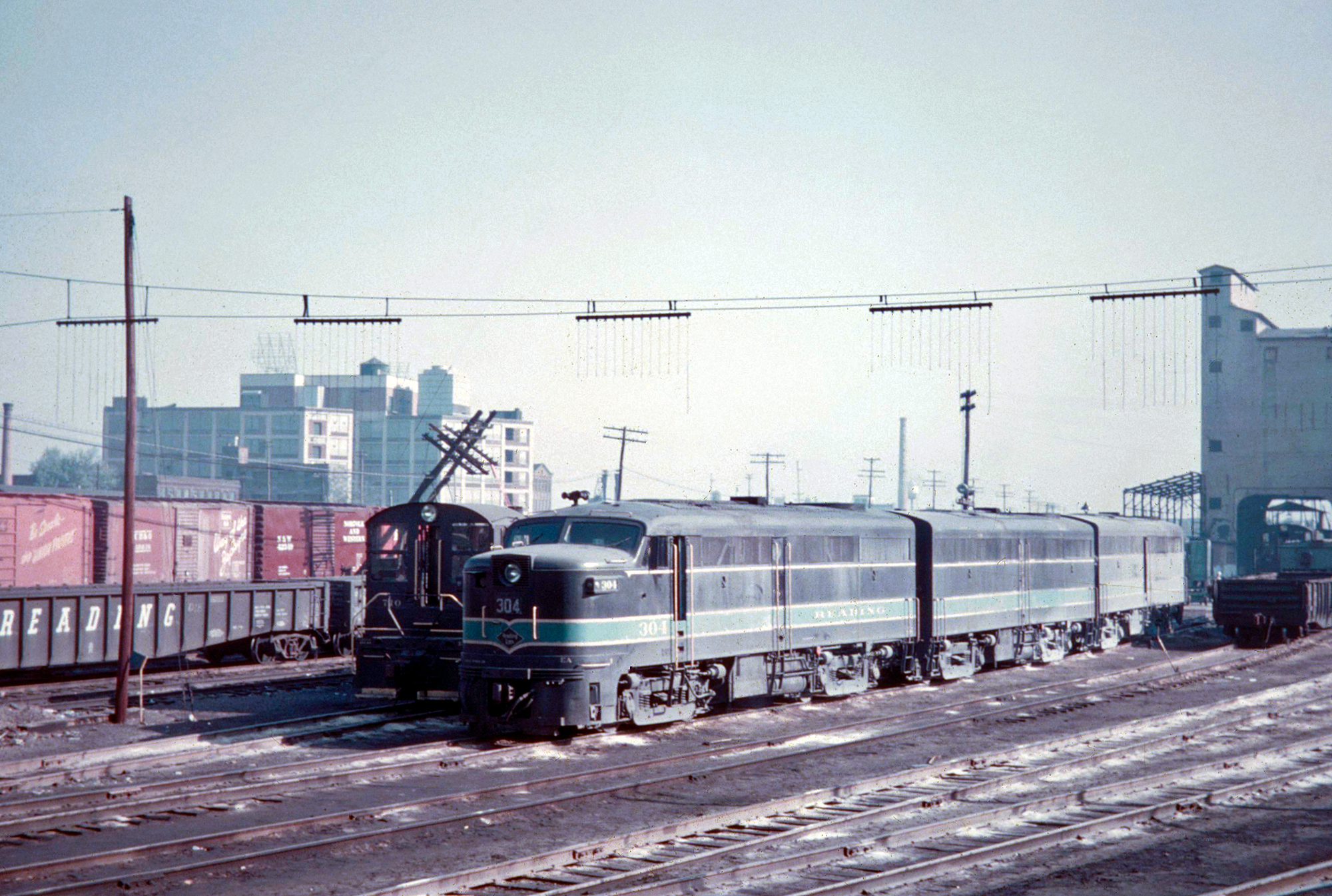 Reading FA-1's and FB-1's layover at the Erie Avenue Yard in Philadelphia during the 1950s. American-Rails.com collection.
Reading FA-1's and FB-1's layover at the Erie Avenue Yard in Philadelphia during the 1950s. American-Rails.com collection.Conrail
As trustees at Penn Central tried to unravel the mess it became clear there were simply too many variables to turn around the company's waning fortunes.
These problems ranged from an incompatible management team to constricting regulations which had harmed the industry for decades.
Realizing the severity of the situation the federal government stepped and setup the Consolidated Rail Corporation, Conrail.
The new carrier comprised the skeletons of several bankrupt Northeastern carriers, including the Reading, and it launched operations on April 1, 1976.
While some systems like the Lehigh Valley and Jersey Central were predominantly scrapped, interestingly, much of the Reading was retained by Conrail.
In 1999 the system, which finally returned to profitability during the early 1980s, was split between Norfolk Southern and CSX Transportation.
Today, these large Class I's continue to operate segments of the old Reading while others sections have been spun-off to short lines (notably the Reading, Blue Mountain & Northern, a successful Class II regional).
Public Timetables (August, 1952)
Contents
Recent Articles
-
Ohio Wine Tasting Train Rides: A Complete Guide
May 23, 25 11:23 PM
Among the intriguing ways to experience Ohio's splendor is aboard the wine tasting trains that journey through some of Ohio's most picturesque vineyards and wineries. -
Pennsylvania Wine Tasting Train Rides: A Complete Guide
May 23, 25 05:56 PM
Wine tasting trains are a unique and enchanting way to explore the state’s burgeoning wine scene while enjoying a leisurely ride through picturesque landscapes -
Wine Tasting Train Rides: A Complete Guide
May 23, 25 03:11 PM
Discover where you can find the unique wine train experiences throughout the U.S., usually found at upscale attractions like the Napa Valley Wine Train and Strasburg Railroad
